Amid ever-escalating aerial assaults, accelerating Russian advances in the east, and the weariness that comes with nearly 3.5 years of war, all eyes in Ukraine are once again focused upon one man — U.S. President Donald Trump.
"I think I'll have a major statement to make on Russia on Monday," Trump said in an interview with NBC News on July 10, the latest development in a tortuously long and so far wholly ineffective U.S.-led peace process.
Short of a massive injection of military aid, or crushing sanctions on Moscow, there's little that Trump could announce that could help Ukraine bring Russia's full-scale invasion to a swift end on terms favorable to Kyiv.
Yet Ukraine has no choice but to play along, a delicate dance with its biggest backer requiring just enough coercion to get Trump to play ball, but not so much that he walks away entirely.
The stakes for Ukraine are existential, and the turbulence of Kyiv-Washington relations since Trump took office means the country — and the rest of Europe — has had to imagine and plan for a life without the U.S., but next door to a newly-emboldened and increasingly militarized Russia.
Key Points
Ukraine adapts to shifting U.S. stance — Despite signs that the U.S. could disengage from the defense of Ukraine entirely, Kyiv has gone to great lengths to keep Washington on board. Relations with the Trump administration are currently at a relative high but questions remain about the extent of support for Ukraine, and the willingness to apply pressure on Russia.Russia's escalating aggression — Russia isn't pretending to placate the U.S.-led peace process anymore and has openly declared its intention to continue the war and believes it can win. This has been accompanied by a dramatic escalation of the aerial war.The battlefield — Russia's grinding offensive in eastern Ukraine is gathering pace despite ever-mounting losses. The prospect of reduced or halted U.S. military aid puts a spotlight on Ukraine's domestic weapons production and asymmetric warfare. There are many positive signs, but significant gaps remain.Europe's response — Rushing to fill the gap being left by a retreating U.S., Europe is racing to ramp up defense production but critics argue the pace is too slow, and the continent is simply not capable of defending itself.Ukraine's people — Despite the bleak outlook, Ukrainian resistance movements continue their work in occupied territories, and polls indicate a large majority believe the country must continue fighting against Russia's full-scale invasion regardless of U.S. support.
Trump bored and stepping away
After Kyiv’s relations with the Trump administration hit rock bottom with the Oval Office argument on Feb. 28 and the subsequent cutting off of military aid and intelligence to Ukraine, developments over spring gave cause for faint hope that Washington would change track.
The key moments came relatively quickly.
In mid-March, a cooler, more calculated Kyiv arrived at a common position with Washington when the foreign ministers of both countries agreed on a joint call for a 30-day unconditional ceasefire to be observed by both sides.
The move broke many of the taboos in Ukraine around a ceasefire without U.S. security guarantees, seen as the basis for a lasting peace. But in return, it aligned Washington with the clear understanding that in rejecting this simple demand, Russia was clearly the main obstacle to stopping the fighting.
"Zelensky has done a good job of managing the personality and the individual that is President Trump," Tom Brewer, a former U.S. Army officer and Nebraska State Senator who has consistently lobbied for more support for Ukraine in the Republican Party, told the Kyiv Independent.
"My concern is that if you surround yourself with people that are anti-Ukraine, they tend to influence that way also."
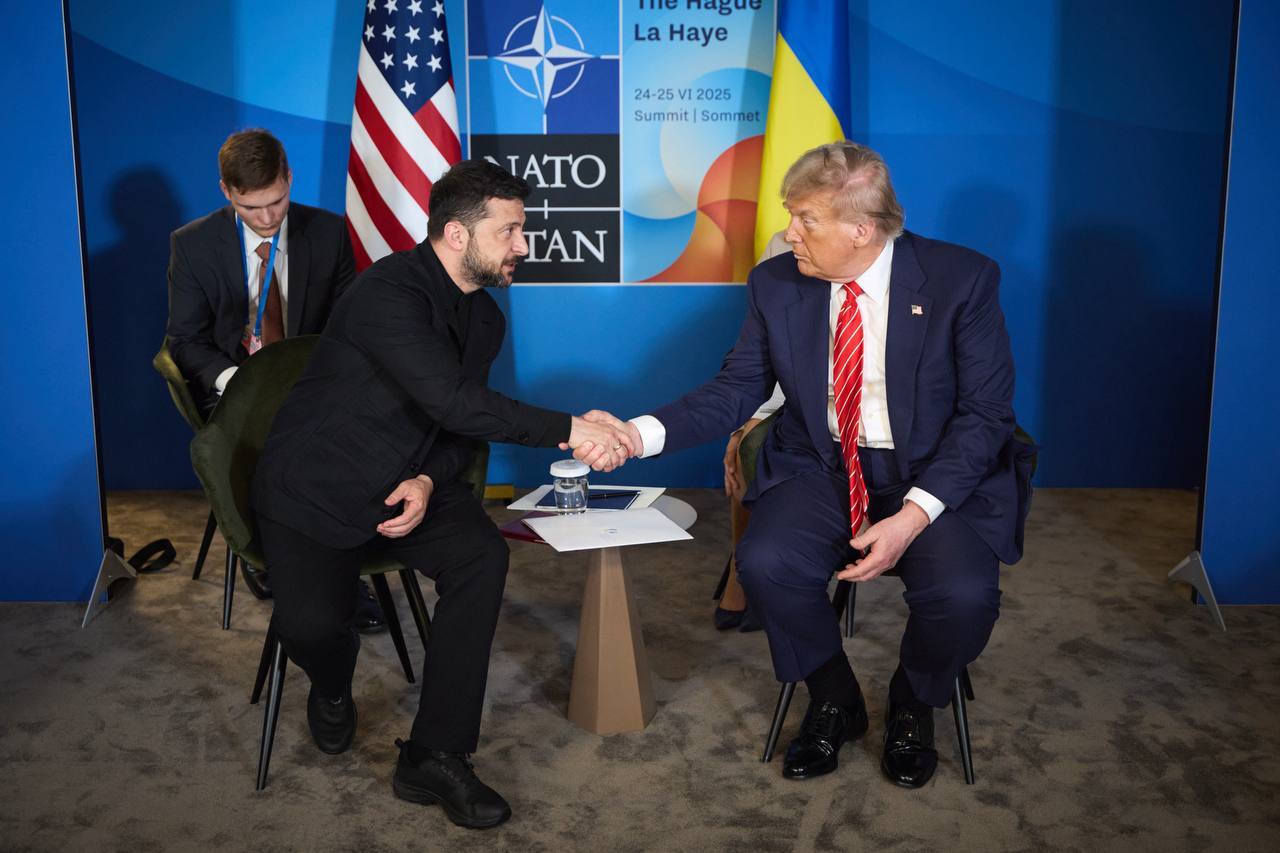 U.S. President Donald Trump and President Volodymyr Zelensky meet during the NATO Heads of State and Government Summit in The Hague, Netherlands on June 25, 2025. (Anadolu via Getty Images)
U.S. President Donald Trump and President Volodymyr Zelensky meet during the NATO Heads of State and Government Summit in The Hague, Netherlands on June 25, 2025. (Anadolu via Getty Images)
Since then, Kyiv has done nearly everything possible to reinforce this position — signing the one-sided minerals deal with the U.S., regular flattering of Trump in public statements, and the readiness to engage in theatrical peace talks in Istanbul where the Russian delegation simply repeated demands for Ukraine to essentially capitulate.
Through all this, the only thing that mattered was Trump’s final decision — whether to either put hard pressure on Russia and compel it to stop its war in Ukraine, or disengage from the process entirely.
From new military aid packages and tightened sanctions to secondary tariffs, potential U.S. leverage on Russia is well-documented, but the willingness to employ it is something else.
"They (the Trump administration) have got two courses of action here," Brewer said, adding: "They either embrace Ukraine, give them the resources they need to be able to sustain the fight and be in a position to eventually put an end to the war, or they walk away." As spring passed, despite sporadic public statements indicating Trump’s patience with Putin was wearing thin — like the president’s "Vladimir, STOP!" Truth Social post after another deadly attack on Kyiv in April — no moves akin to real action were made.
While media, pro-Ukraine Republicans, and supporters of Ukraine across the world grasped at every moment Trump criticized Putin, the U.S. leader, echoed by Vice-President JD Vance and Secretary of State Marco Rubio, started saying the quiet part out loud — that Washington could step away from active peace efforts if it seemed the sides’ demands were too far apart.
"I think in a sense, the decision has already been made by Trump not to apply pressure," Eric Ciaramella, senior fellow in the Russia and Eurasia program at the Carnegie Endowment for International Peace, told the Kyiv Independent.
"He's communicated that in just about every different possible way, that he doesn't see it as productive."
For months, Trump instead chose a third path — to continue in circles, ignoring Ukraine bar the occasional comment, and avoiding any responsibility for bringing peace to the war he originally said he could end in 24 hours.
In June, as focus shifted to the Middle East and Trump’s airstrikes on Iranian nuclear facilities, key summits came and went at the G7 and NATO.
The meetings brought varying optics but the same end result: little interest in progress — let alone progress itself — towards a tougher U.S. position on Russia.
"This administration is extremely performative," Ciamarella said. "And I think there's an extreme lack of expertise on the region, on the war, but also on how to create policy.
After the Pentagon announced the cancellation of ammunition for artillery and air defense deliveries to Ukraine — those already planned and funded under the President Joe Biden administration — the question looked to be resolved beyond doubt.
The aid freeze ultimately proved to be a false alarm, and in the weeks following, Trump’s rhetoric towards Putin has soured further, but still, no signs of a hard policy shift are evident.
One last possible test will be the Congressional bill on anti-Russia sanctions proposed by Republican Senator Lindsey Graham, which calls for aggressive U.S. tariffs on countries like China and India if they continue buying Russian oil.
But with the Iran-Israel conflict pushing up world oil prices already, and Trump pushing Graham to water down the bill and add a presidential waiver, the chances of it translating into action are slim.
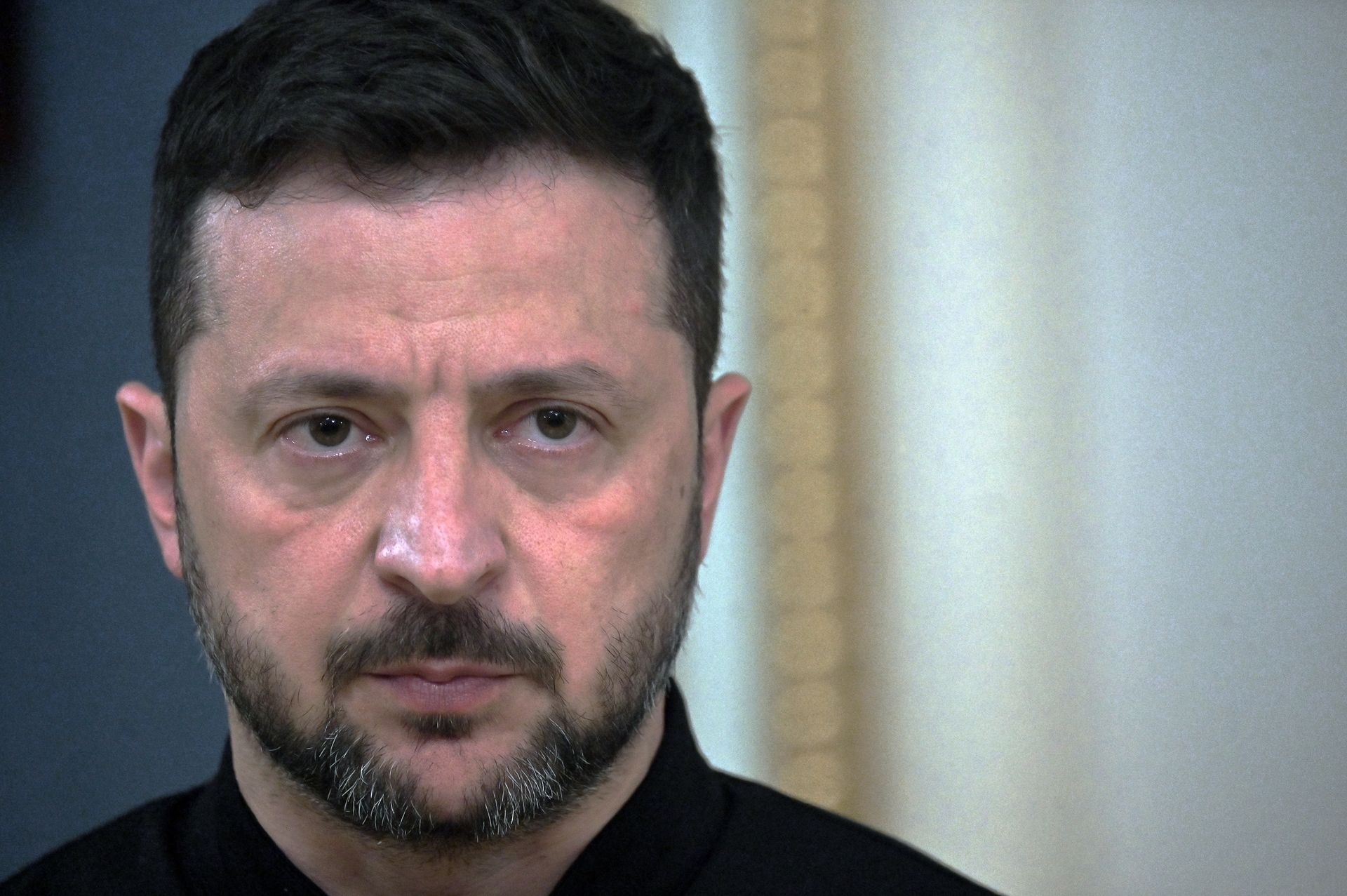 President Volodymyr Zelensky speaks to the media during a press briefing after his phone talks with the U.S. President Donald Trump on May 19, 2025. (Sergei Supinsky/AFP via Getty Images)
President Volodymyr Zelensky speaks to the media during a press briefing after his phone talks with the U.S. President Donald Trump on May 19, 2025. (Sergei Supinsky/AFP via Getty Images)
Ultimately, increased pressure on Moscow requires pro-active, calculated decisions from a U.S. president who has not only repeated Russian propaganda narratives on the war, but has shown little interest in the basic rules-based world order that the defense of Ukraine is paramount to upholding.
"He will answer things in a roundabout way and kind of try to keep people guessing," Ciamarella said. "But I think Trump's made his position pretty clear — he doesn’t care."
"Russia is bombing the hell out of Ukrainian cities every day, and he doesn't have anything to say about it."
Russia's position
After months of paying lip service to the U.S.-led peace process, Russia is now saying the quiet part out loud — it has no intention of stopping its war or agreeing to a ceasefire and believes it can win.
"We do not see any necessity to stop," Russia's ambassador to the United Kingdom, Andrei Kelin, said in a June 18 interview with CNN.
"We continue to acquire more and more (territory). For Ukraine there is a choice — either they will take our conditions right now… or we will continue this drive and Ukraine will have to surrender under much worse conditions."
Just two days later in a speech in St. Petersburg, Russian President Vladimir Putin went one step further, declaring that "all of Ukraine" belonged to Russia.
"Wherever the foot of a Russian soldier steps is Russian land," Putin said, directly implying Russia's intention to continue occupying more than just the five Ukrainian regions that Moscow has illegally laid claim to — Donetsk, Luhansk, Zaporizhzhia, and Kherson oblasts, as well as the Autonomous Republic of Crimea.
Across Ukraine, the increasingly aggressive official statements about Moscow's final territorial ambitions have been accompanied by a dramatic escalation in Russia's aerial war, with cities far from the front lines facing unprecedented levels of drone and missile bombardment.
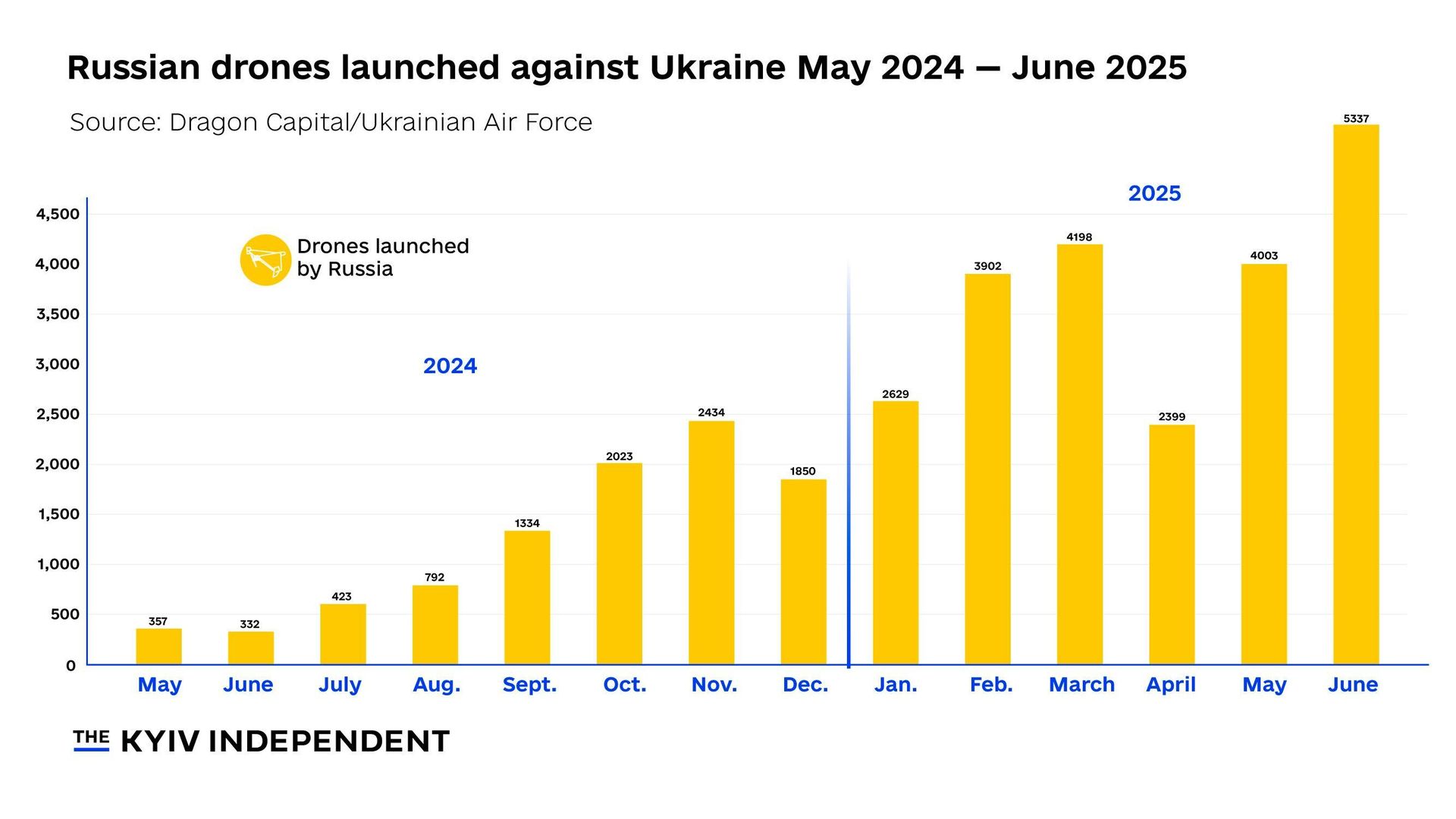 Number of Russian drones launched against Ukraine in May 2024 — June 2025. (Nizar al-Rifai/The Kyiv Independent)
Number of Russian drones launched against Ukraine in May 2024 — June 2025. (Nizar al-Rifai/The Kyiv Independent)
"You lie down, look into the abyss of night, and hear the loudest attack, and you think the end has already come," Hryhorii Matsebok, a 47-year-old artist, told the Kyiv Independent after the latest strike on the capital on July 10.
Ukraine's position
For Ukraine's president, keeping Trump onside and effectively conveying what is at stake for his country remains paramount.
"For us, it’s a priority to maintain U.S. support," President Volodymyr Zelensky said last month during a closed-door meeting with journalists attended by the Kyiv Independent.
After a noticeable pause when asked what would happen if Trump disengaged from Ukraine's defense against Russia's full-scale invasion, he voiced hope that Trump would make "the historically correct choice" to stand with Kyiv.
"Of course, there are European countries that have already signaled they will stand with Ukraine even in the most difficult situation — and the most difficult situation, in my opinion, would be one without America's involvement," he added.
During the two weeks since, there have been some positive signs — Trump's public statements recently have softened towards Ukraine and hardened against Russia and its president.
At the same time as announcing his "major statement" on Russia next week, Trump also said he was "disappointed in Russia," but added that "we'll see what happens over the next couple of weeks."
Trump also announced a new arrangement whereby NATO would collectively pay for new weapons to be sent to Ukraine.
But the discussions currently are centered on relatively tiny amounts of military aid — like the promised 10 Patriot interceptor missiles, a far cry from the multi-billion dollar packages sent during President Biden's time in office.
"It’s not enough to defeat Russia and to return the occupied territories," Oleksandr Merezhko, a Ukrainian lawmaker and chair of the parliament's foreign affairs committee, told the Kyiv Independent.
"I’m not even sure that this aid is enough to compel Putin to start serious negotiations about a ceasefire. The key issue is how to create at least parity between Russia and Ukraine in terms of weaponry."
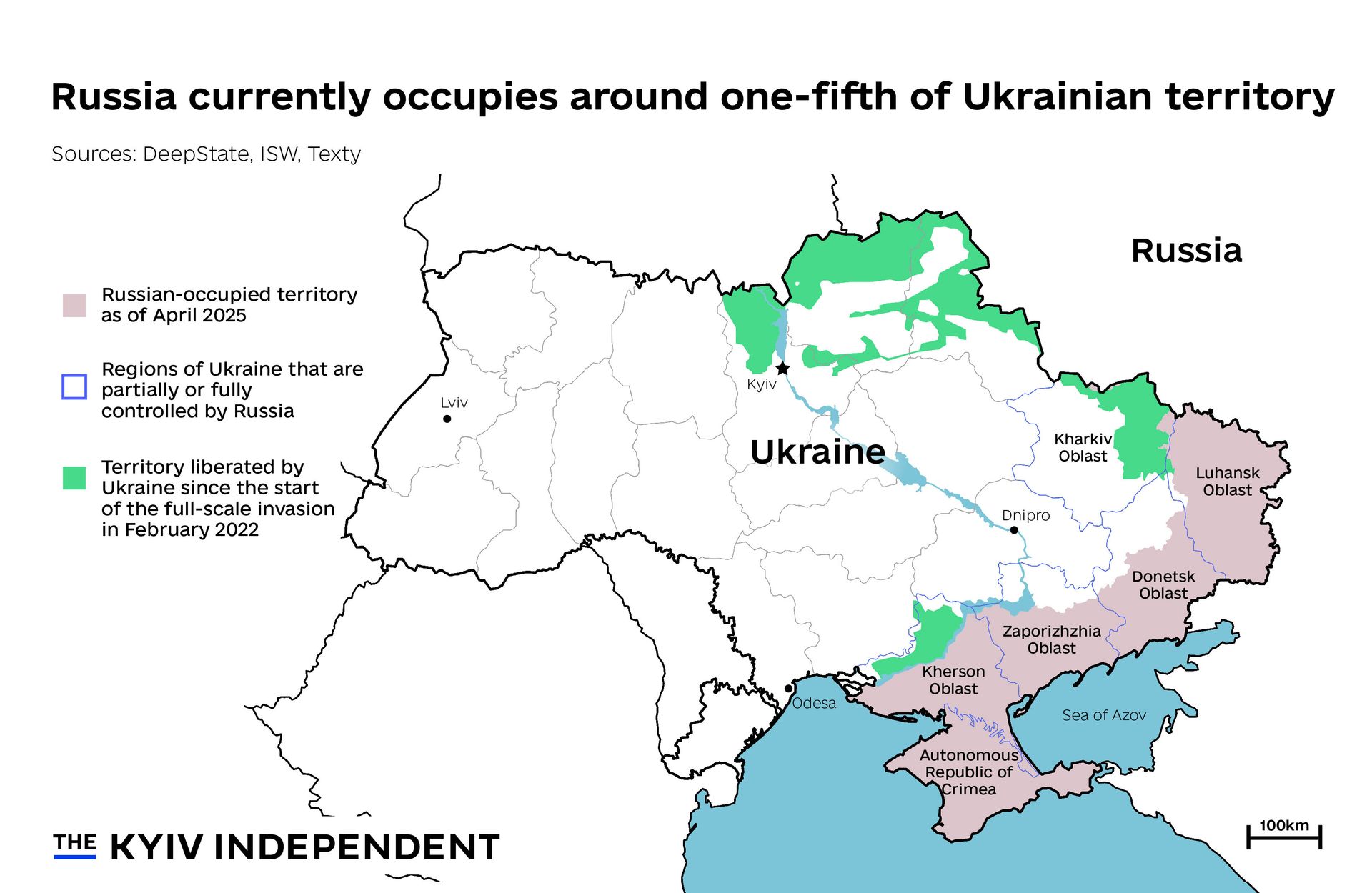 A map of Ukraine and its Russian-occupied territory. (Lisa Kukharska / The Kyiv Independent)
A map of Ukraine and its Russian-occupied territory. (Lisa Kukharska / The Kyiv Independent)
For any hope of this happening, Ukraine has no choice but to keep the U.S. onside. But if Kyiv has learned one thing this year, it's that a positive relationship with the U.S. president can change in a second, and nothing can be taken for granted.
Speaking of current Kyiv-Washington relations, some observers still point to the 2019 impeachment scandal, believing it laid the groundwork for rocky relations between Trump and Zelensky, fueled by the U.S. president’s lingering resentment.
"It’s almost impossible to change Trump’s bias against Ukraine," Merezhko said.
"Still, Zelensky has no choice but to try to build at least some kind of constructive relationship with Trump. The Americans have the weapons we need, ones that the Europeans simply don’t have."
The battlefield
Amongst a sea of falsehoods and propaganda narratives, one statement made consistently by Moscow on their vision for the end of the war is coldly honest — that any peace plan must reflect the "realities on the ground."
Translated, there is ultimately no factor more crucial for the end of Russia’s war than the dynamic on the battlefield.As illusions of negotiated peace and a change of heart in the White House fade, Russia’s summer offensive campaign has stepped up a gear on the battlefields of eastern Ukraine.
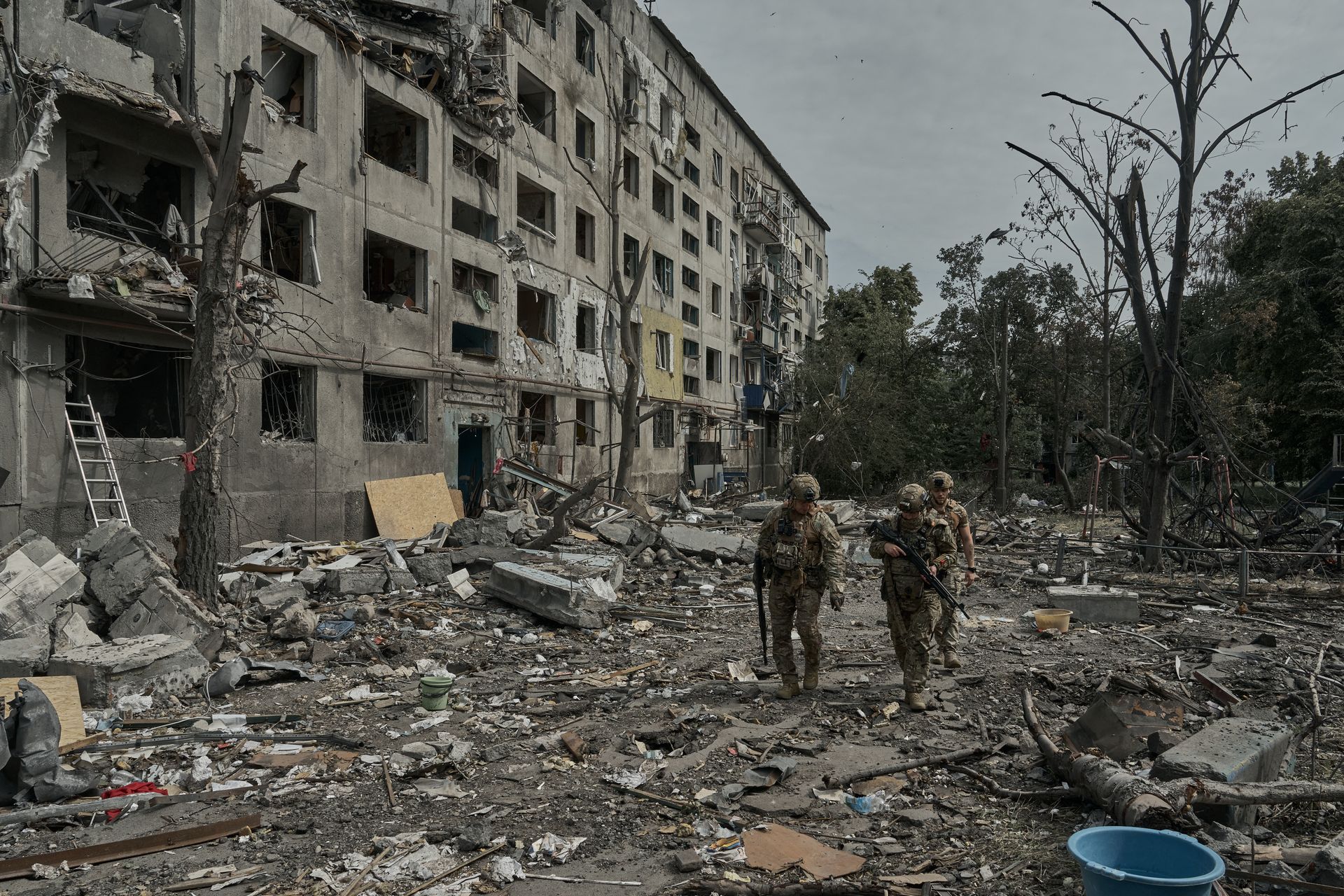 Evacuation of civilians from the city by the forces of the National Police of Ukraine "White Angels" unit on June 19, 2025, in Pokrovsk, Donetsk Oblast, Ukraine. (Kostiantyn Liberov/Libkos/Getty Images)
Evacuation of civilians from the city by the forces of the National Police of Ukraine "White Angels" unit on June 19, 2025, in Pokrovsk, Donetsk Oblast, Ukraine. (Kostiantyn Liberov/Libkos/Getty Images)
After winter conditions and the exhaustion of Russian offensive momentum saw Ukrainian lines largely stabilize in March, Russian advances have picked up again sharply over May and June.
According to figures published by Ukrainian open-source mapping project Deep State, Russian territorial gains amounted to approximately 449 square kilometers in May, up 253% from the April figure.
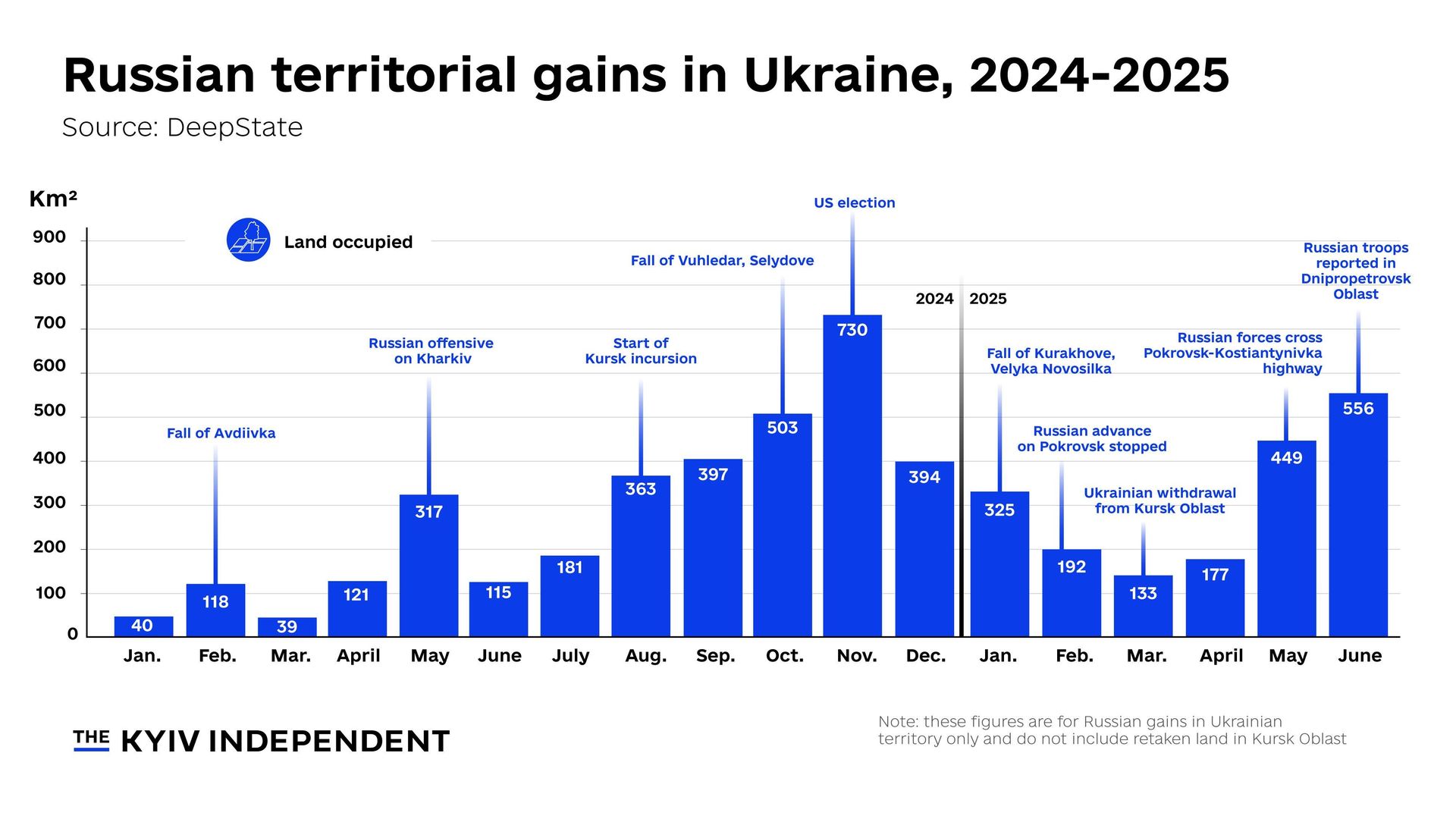 Russian territorial gains in Ukraine in 2024-2025. (Nizar al-Rifai/The Kyiv Independent)
Russian territorial gains in Ukraine in 2024-2025. (Nizar al-Rifai/The Kyiv Independent)
In the grinding positional fight of Russia’s war in Ukraine, these numbers reflect a certain level of disorder, if not collapse, in given sectors of the front line.
Fueled by a steady stream of contract recruits and backed by the deadly choke hold of drones on Ukrainian infantry and logistics, Russian forces have been able to push hard on the weak points in Ukrainian lines, defended by less combat-effective, more poorly-coordinated brigades.
As of July, the hotspots of the front line remain in Donetsk Oblast.
In the most dramatic push of the spring/summer campaign, Russian forces have flooded forward between the key cities of Pokrovsk and Kostiantynivka, threatening both with gradual, partial encirclements that could make their defense untenable. Meanwhile, gains in the south of the oblast have brought Russia’s ground war to a new Ukrainian region — Dnipropetrovsk Oblast.
After gains sped up in June, Russia’s cross-border offensive on Sumy Oblast has slowed, but pressure there continues to create dilemmas for the overstretched Ukrainian defense, military analyst Rob Lee, Senior Fellow at the Foreign Policy Research Institute’s Eurasia Program, told the Kyiv Independent.
Though a shortage of U.S.-made equipment like the Patriot air defense systems raises alarms for the defense of cities and critical infrastructure from Russian missiles, the looming end of U.S. military aid deliveries is now less critical for Ukraine on the battlefield itself.
"If Russia can keep pushing closer to the city of Sumy and place it at greater risk, it could give them greater leverage during negotiations and force Ukraine to divert more forces from Donetsk," Lee said.
Spurred by the shell shortage brought on by the Republican blockade of the last U.S. aid package last year, Ukraine invested heavily in domestic production of strike drones of all shapes and sizes, while putting their best drone units on a path of constant expansion.
The result — a consistent, mobile source of home-grown firepower which can be deployed to stop Russian offensives in their tracks, and which greatly reduces Ukraine’s dependence on artillery ammunition.
"Some of the key metrics for assessing combat power from 2022-2023 are less significant today," Lee said."Artillery is no longer the greatest casualty-producing weapon in the war, so the relative artillery fire rate is not as significant a metric as it once was."
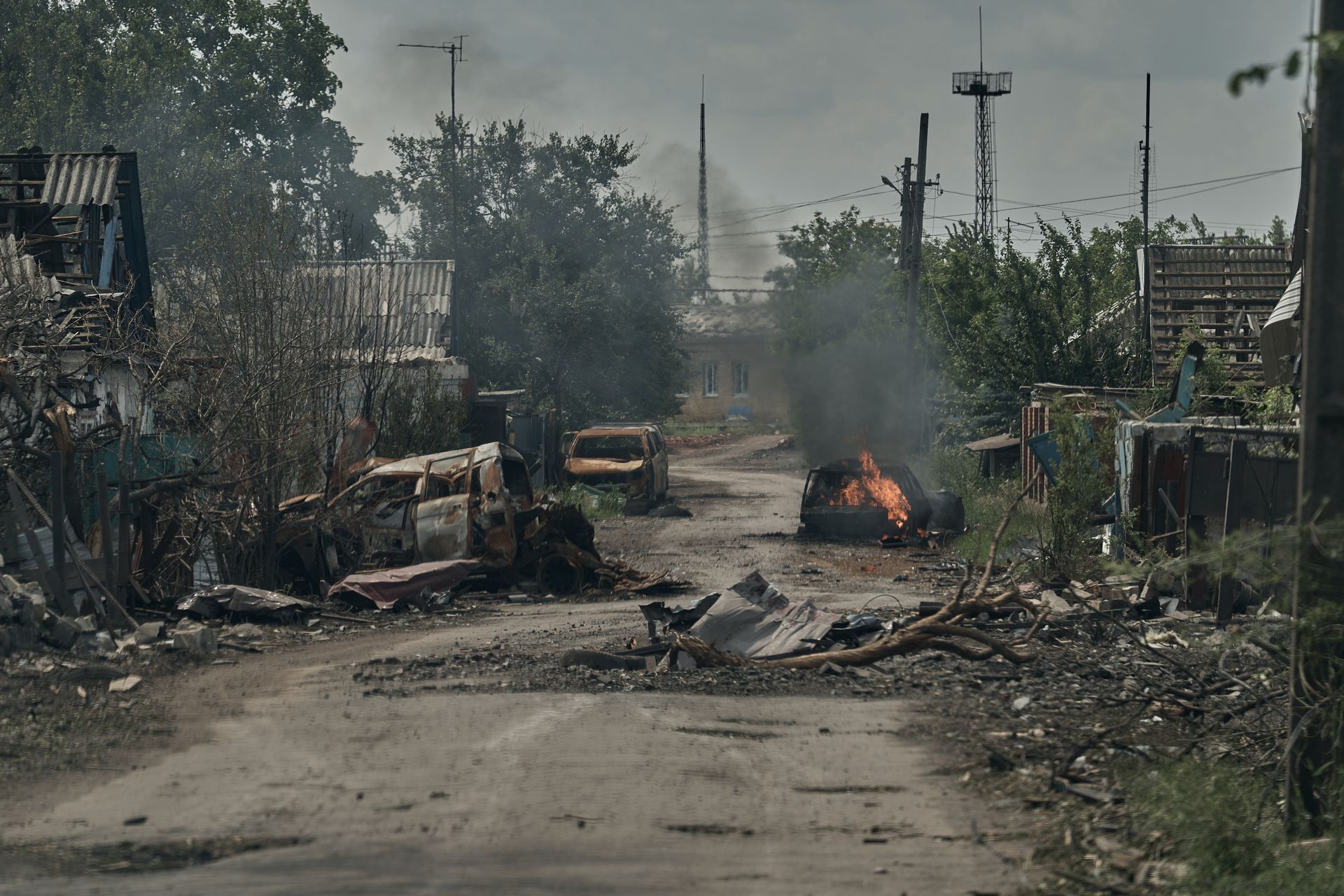 Burnt cars lie in the street on June 19, 2025 in Pokrovsk, Donetsk Oblast, Ukraine. (Kostiantyn Liberov/Libkos/Getty Images)
Burnt cars lie in the street on June 19, 2025 in Pokrovsk, Donetsk Oblast, Ukraine. (Kostiantyn Liberov/Libkos/Getty Images)
Since the beginning of 2024, Ukraine’s main battlefield challenge has been not a lack of weapons and ammunition, but the ability to field enough combat-effective manpower to cover an active front line of over 1,200 kilometers.
Meanwhile, going forward, lacking the ability to conduct large-scale maneuver breakthroughs, Russia’s prospects of continuing its advance will rest on the continued ability to feed new recruits into seemingly endless infantry-based assaults.
Over 2025, despite Russian casualties surging past one million as per Ukrainian figures, tens of thousands of Russian men continue to enlist, with Zelensky putting the figure at 45-50,000 in late May.
Without the luxury of such flows of fresh expendable infantry and Moscow showing no signs of stopping, Kyiv must do everything it can to wage the most efficient attritional war possible.
Over the rest of the summer and autumn campaign, which side that attrition equation favors could well be the difference between war and peace.
"If, by the winter, Russia struggles to improve its position on the battlefield, it may decide that the costs of continuing the war are not worth future likely marginal gains," Lee said.
"Conversely, if Russia achieves greater battlefield successes this summer or it appears Ukraine is struggling to sustain the war, then Russia’s leadership may decide the situation still favors them and keep pressing."
The weaponry
Ukraine’s domestic arms industry is in a tough spot, but it’s not an unprecedented tough spot.
The pullback in U.S. political support for Ukraine under the Trump administration has been tough on Ukrainian morale, but has belied the fact that material aid had already slowed to a crawl by the time he took office.
An unfortunate and undeniable truth is that Russia has successfully scaled its military-industrial complex into a behemoth — at the expense of Russian society, but, unlike Ukraine’s Western allies, with an unambiguous commitment to fueling the war machine on the other side of the line.
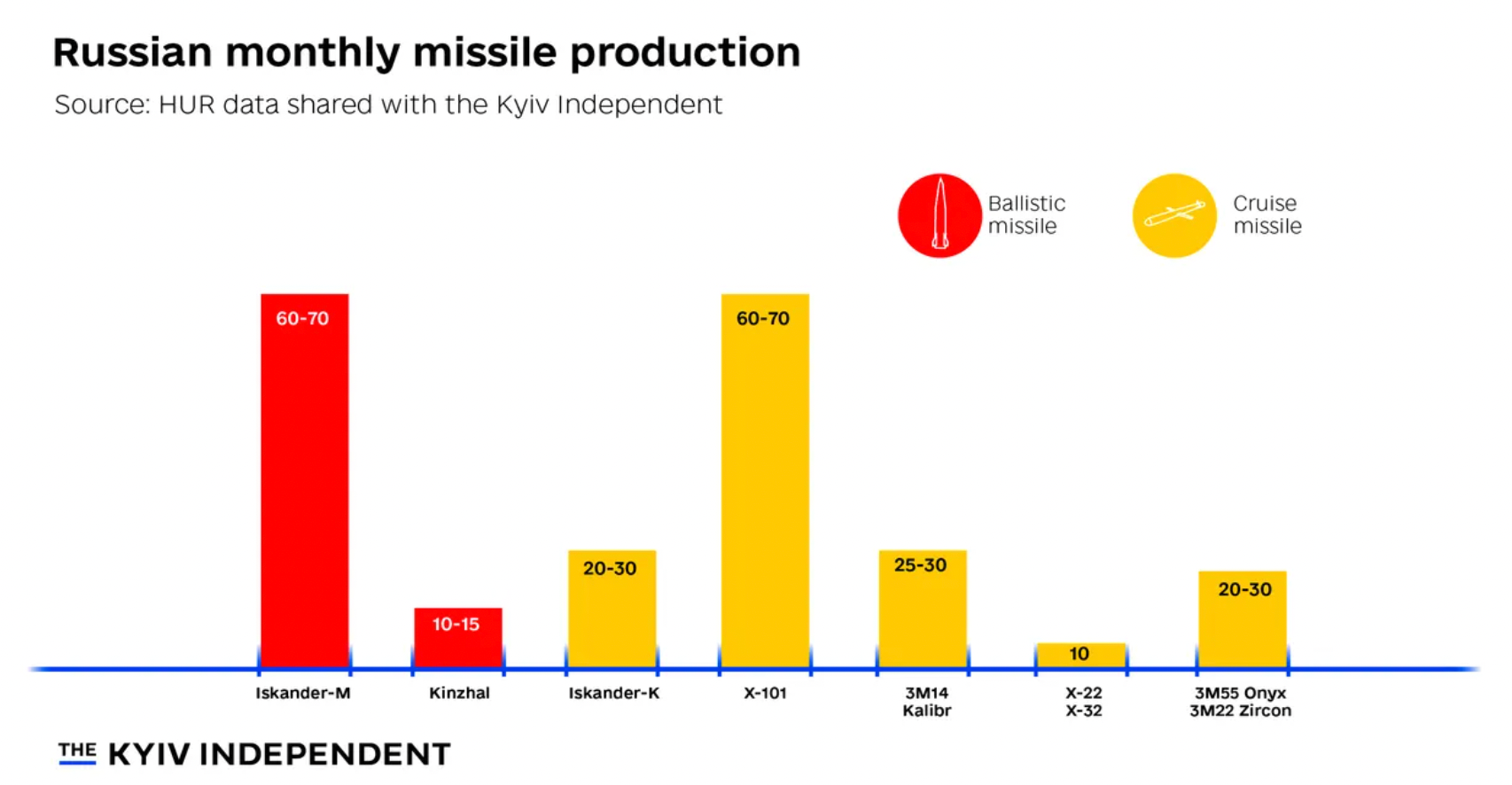 Russian monthly production of the various types of missiles according to data obtained by HUR and shown to the Kyiv Independent in June 2025. (Nizar al-Rifai/The Kyiv Independent)
Russian monthly production of the various types of missiles according to data obtained by HUR and shown to the Kyiv Independent in June 2025. (Nizar al-Rifai/The Kyiv Independent)
Ukraine’s key advantage remains flexibility and adaptability. Ukraine keeps the details of many parts of productive capacity a closely held secret, for obvious reasons. Major factories face constant bombardment. Much new production happens in small, unmarked and, if Ukraine’s defense forces have their way, unidentifiable locations.
Distributed production may not match post-Soviet megafactories out in Siberia for scale, but it keeps producers running.
Raw materials for defense of the type that absolutely require economies of scale continue to come from outside of Ukraine itself, but they do keep coming.
Production of domestic defense darlings like drones and electronic warfare devices is, those involved say, higher than ever. The problem remains funding established production lines.
Ammunition remains a sticking point. Supplies of gunpowder and explosives with which to fill ordnance depend on chemical imports that are limited. Absent artillery, Ukraine’s ability to blow up Russian entrenchments and make major assaults remains limited.
"It’s collectively important for us to have more options for production of explosives," said Kateryna Mykhalko, the director general at Tech Force in UA, a trade association for Ukrainian defense companies, adding that while there are "hundreds" of drone production facilities in Ukraine, there are only "dozens" of explosives manufacturers.
Nonetheless, Ukraine’s method of defense remains remarkably resilient. FPV pilots hold their ground against a mass of Russian soldiers testing the line, thanks to that same remarkable homegrown supply of drones
Despite Russia’s relative success in industrializing electronic-warfare-proof fiber-optic drones, many of their offensive pushes to seize land rely on throwing under equipped soldiers out for the slaughter.
In Sumy Oblast, for example, this includes rag-tag gangs of recent recruits thrown on quad bikes, electric scooters, or sometimes just hobbling on foot into the remnants of Ukrainian villages to secure any sort of position they can. This typically means a march to their deaths by FPV.
Another video of Russian soldiers using electric scooters. https://t.co/iJBUo2Iafc pic.twitter.com/yg6irsVOTS
— Rob Lee (@RALee85) July 30, 2024
An underreported area of development is Ukrainian mid-range strikes. With Ukrainian FPVs clearing out Russian equipment for miles behind the front line, Russia has moved its most valuable kit — including armored vehicles, large electronic warfare equipment, and air defense units like the S-300, S-400s, or Buk systems — further to the rear.
Ukrainian drone producers are hastening to extend their range beyond the radio horizon, the point at which direct signals communication fails due to the simple geometry of the earth, around 40 kilometers.
Deep-strike drones rely on more boutique means of steering and control, including the pirating of Russian SIM cards and subtle jacking of civilian cellular networks.
For the more immediate needs behind the radio horizon, they are experimenting with signal-repeating drones that go into the sky and can act as midway points to control cheaper strike drones beyond the radio horizon. Scalable success in the production of such drones would force Russian vehicles ever further away from being useful to support troops in the frontline.
In good news for Ukrainian kit, the Americans were showing more in the way of support for Ukraine at the recent NATO summit than they have since the very public falling out with Zelensky in the Oval Office.
"He couldn’t have been nicer," Trump said of a meeting with Zelensky. "He is fighting a brave battle, it's a tough battle."
Air defense is a critical area for Ukraine, which is bootstrapping some faculty at shooting down Russian drones and cruise missiles, but isn’t yet capable of mounting a reliable defense against Russian ballistic missiles.
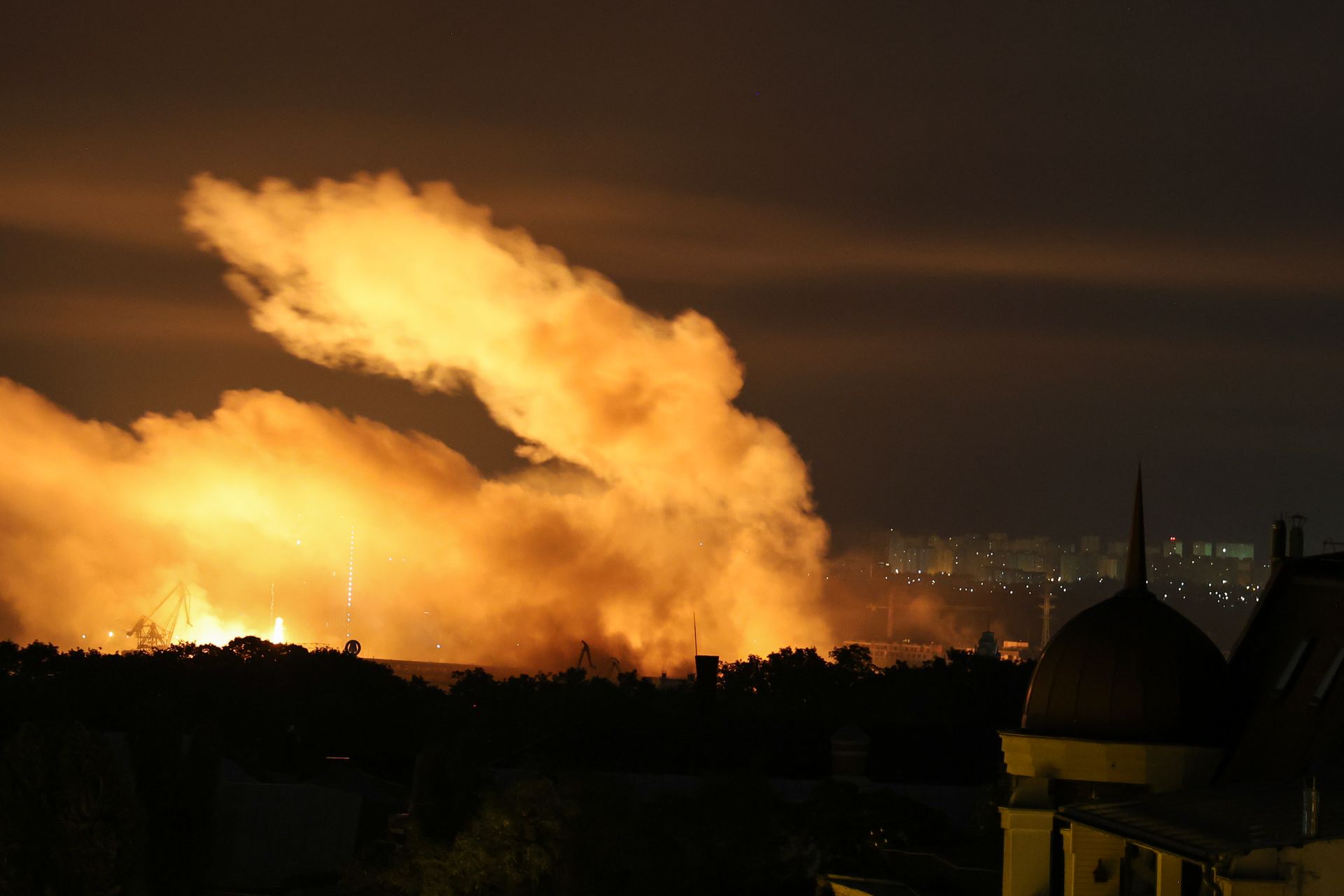 A fire breaks out over the city during Russian air attack on July 10, 2025 in Kyiv, Ukraine. (Ivan Antypenko/Suspilne Ukraine/JSC UA:PB via Getty Images)
A fire breaks out over the city during Russian air attack on July 10, 2025 in Kyiv, Ukraine. (Ivan Antypenko/Suspilne Ukraine/JSC UA:PB via Getty Images)
Trump — after a brief and unsettling pause — has teased earlier this week a renewed supply of Patriot missiles that would be a small but vital boost to Ukraine’s ability to protect itself from the Russian aerial threat.
The new generation of Ukrainian defense producers are well accustomed to setting up shop in short-term facilities with limited machining tools, thanks to repeated Russian attacks on factories and workshops within Ukraine.
Given the resources, space, and legal authorization, they are likely to get production rolling off the line quicker than their larger but bulkier European partners would necessarily believe possible.
The asymmetric war
During the David and Goliath battle against Russia's military and manpower superiority, there's no denying that Ukraine has honed the art of asymmetric warfare.
Nearly every part of Moscow's war machine has come under attack, even if located deep inside Russian territory — fighter jets, military helicopters, large vessels of Russia's Black Sea Fleet, Russian military production facilities such as the Shahed-style drone factory in Yelabuga, infrastructure facilities for the delivery of military cargo such as the Crimean bridge, and oil refineries.
Not to mention the audacious June Operation Spiderweb targeting Russia's strategic bombers and surveillance aircraft deep inside Russian territory.
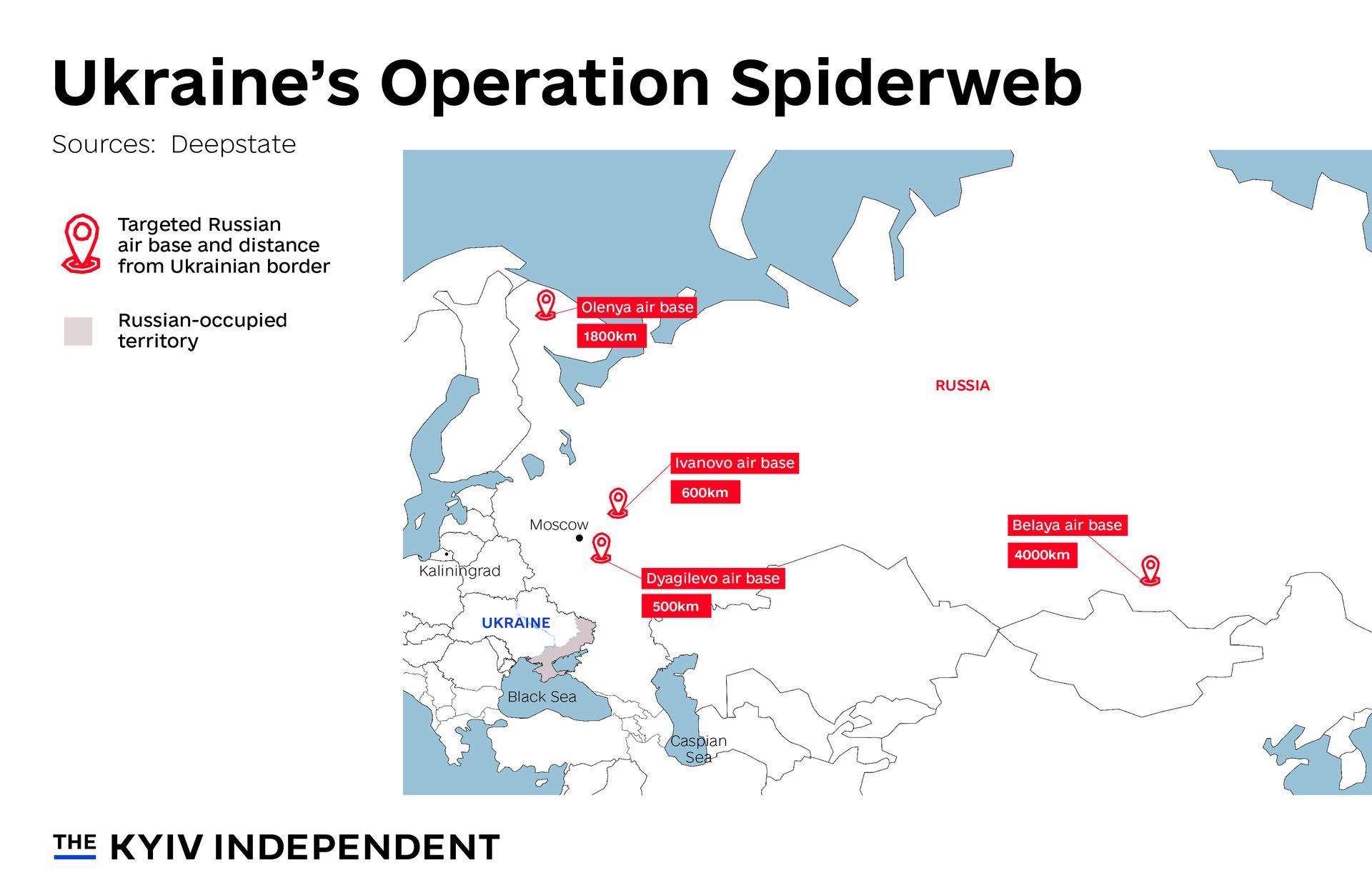 Targets in Ukraine's Operation Spiderweb in June 2025. (Nizar al-Rifai/The Kyiv Independent)
Targets in Ukraine's Operation Spiderweb in June 2025. (Nizar al-Rifai/The Kyiv Independent)
Some of the results have been strategically spectacular — Ukraine has managed to put Russia's Black Sea Fleet out of action, a third of it destroyed, the rest now contained in the southeastern part of the Black Sea.
Relatively cheap Ukrainian weapons have effectively disabled — and in some cases sunk — multi-million dollar ships.
"The Russian naval forces are locked in harbors. Seven-meter-long Ukrainian (attack) boats have driven warships into ports and cleared the field for the merchant fleet in the Black Sea," a source in the Security Service of Ukraine (SBU) told Kyiv Independent.
To do this Ukraine has developed the Magura and SeaBabу' sea drones, operated by Ukraine's military intelligence agency (HUR) and the SBU, respectively.
"All the HUR's and SBU boats combined and multiplied by 10 still cost less than construction of a full-fledged combat vessel from scratch. And this is how we 'turned off' the Russian fleet. Not completely destroyed, but almost took it out of the game," the source in the SBU added.
Operation Spiderweb used even cheaper FPV drones — 117 of them carrying explosives attacked Russia's strategic bombers and surveillance aircraft, reportedly causing $7 billion in damage and disabling one third of Russia's cruise missile bombers, and at least one of approximately seven remaining Russian A-50 early warning aircraft.
But experts who spoke to the Kyiv Independent said there's only so much Ukraine can achieve with asymmetric drone strikes, no matter how elaborate and spectacular these are.
Particularly in a future without U.S. support, Ukraine needs to focus on another weapon — missiles.
"Drones do cause damage — they can fly into windows at defense factories deep in Russia's rear," Ivan Stupak, a former SBU officer and a former Ukrainian lawmaker, told the Kyiv Independent.
"But let's be honest, 50 kilograms of explosives are just 50 kilograms — 500 kilograms in a missile can make a difference".
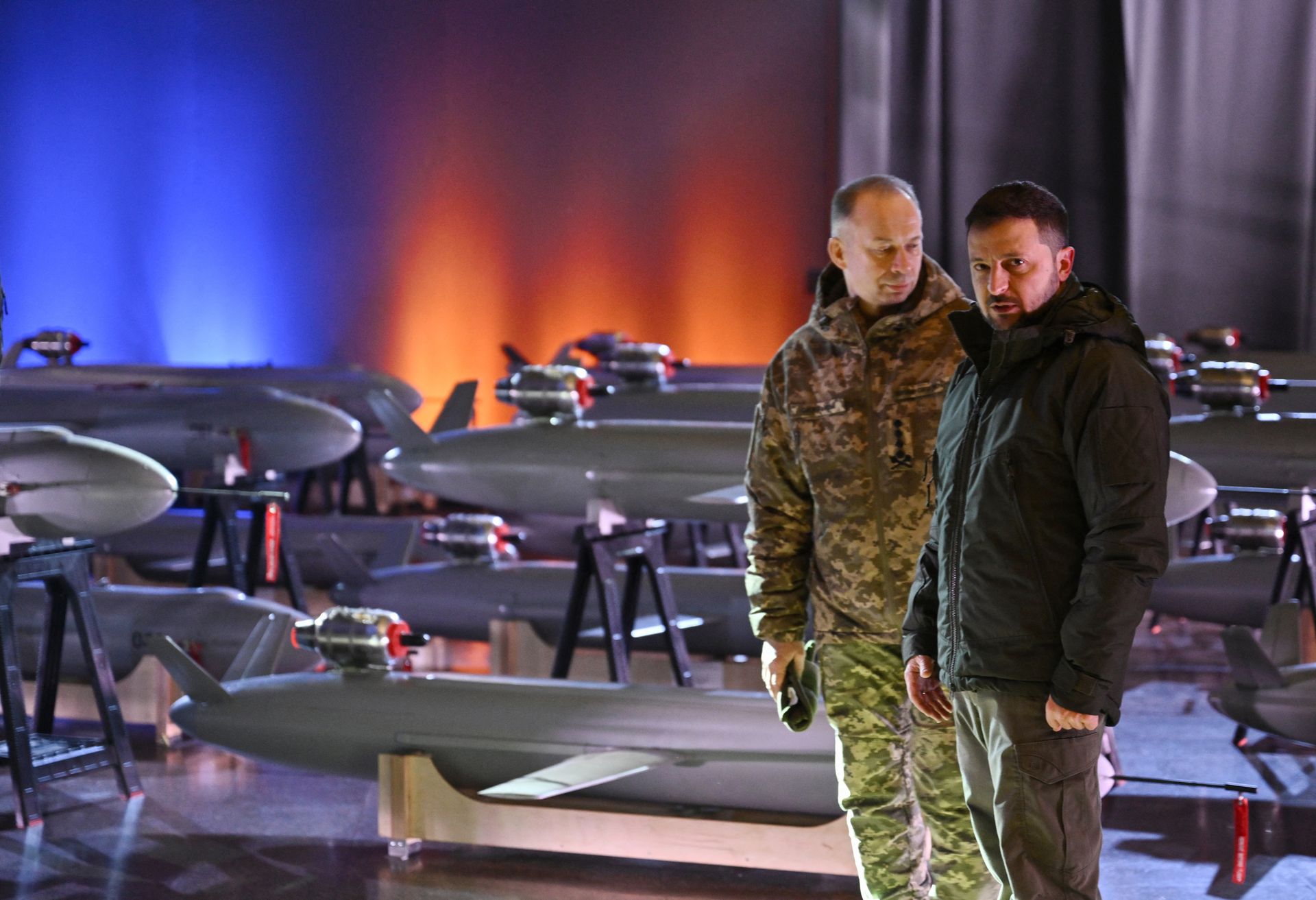 President Volodymyr Zelensky (R) and Commander-in-Chief of the Armed Forces of Ukraine Oleksandr Syrsky in front of the first batch of Ukrainian-made drone missiles Peklo (Ukrainian for "hell"). (Genya Savilov/AFP via Getty Images)
President Volodymyr Zelensky (R) and Commander-in-Chief of the Armed Forces of Ukraine Oleksandr Syrsky in front of the first batch of Ukrainian-made drone missiles Peklo (Ukrainian for "hell"). (Genya Savilov/AFP via Getty Images)
Stupak hopes that a recently-announced initiative with Germany to joint purchase "long-range missiles" made by Ukrainian producers could be a key part of Ukraine's future attack capability.
"I am not saying that it will immediately stop Russia's offensive, but imagine if Ukrainian missiles were fired at the locations of Russian troops in the occupied territories," he said.
"This could seriously affect the course of hostilities," he added.
Until then, Ukraine has no intention of halting the asymmetric tactics it has already honed.
"As long as Russia's criminal genocidal war against Ukraine continues, there is no question of any end to the naval and other campaigns," Andrii Yusov, HUR's spokesperson, told the Kyiv Independent.
"HUR fighters continue their work, including in the Black Sea, to maintain and scale the advantage gained in naval combat over Russia."
Europe starts to think about war
Europe's leaders are scrambling to ready the continent for a potential war with Russia — but critics say the pace is still far too slow to meet not only the scale of the threat, but the grim reality of the situation facing Ukraine.
There are significant positives — at the NATO summit in The Hague last month alliance leaders endorsed a new target of 5% of GDP on defense spending, a level not seen since the last century.
But there are also glaring negatives — a European defense industry simply not capable of filling the gap left by a retreating U.S., and political and military plans completely reliant on the belief that Russia will just stop its war and agree to a ceasefire.
Lithuania's ex-Foreign Minister Gabrielius Landsbergis said that even the thawing Washington-Kyiv relationship and Trump's hardening stance against Putin are not signs of progress.
"We are still in the same paradigm as before, unfortunately," he told the Kyiv Independent. "And Putin understands and plays the game — if Trump is unhappy there is a statement from the Kremlin and then there is a new two-week deadline."
"And so it goes. The question is — how long can Ukraine hold on like this and how long until Europe understands that it’s Europe’s war?"
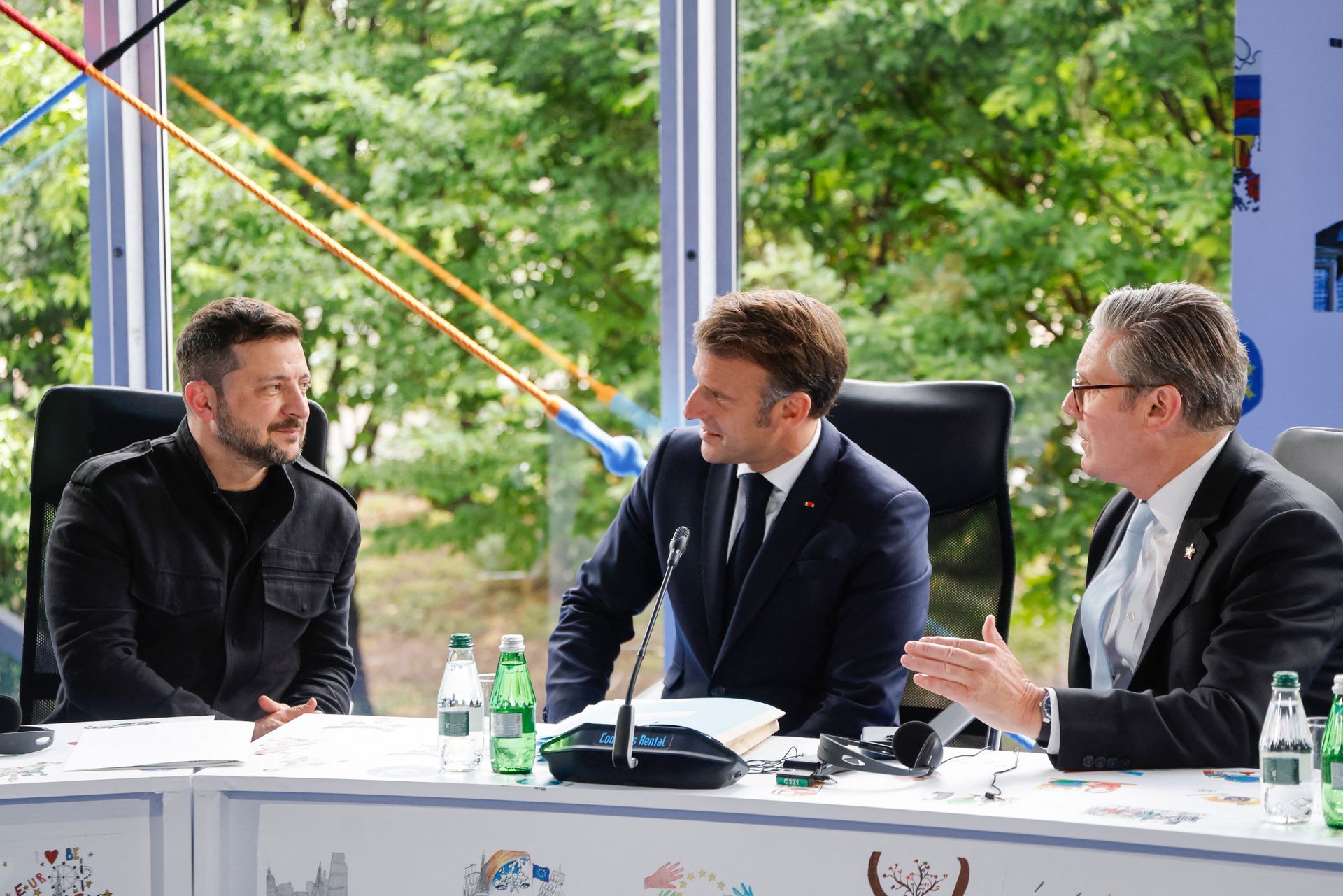 President Volodymyr Zelensky, France's President Emmanuel Macron and Britain's Prime Minister Keir Starmer attend a meeting during the European Political Community (EPC) summit, in Tirana on May 16, 2025. (Ludovic Marin/AFP via Getty Images)
President Volodymyr Zelensky, France's President Emmanuel Macron and Britain's Prime Minister Keir Starmer attend a meeting during the European Political Community (EPC) summit, in Tirana on May 16, 2025. (Ludovic Marin/AFP via Getty Images)
On the defense production front, there is also little to look forward to that is positive.“There's not enough supply to answer the demand,” a senior NATO official told the Kyiv Independent on condition of anonymity, warning that Europe’s defense industry just isn’t up to the task of defending the continent.
And yet, the threat is there.
“If you listen to different sources and intelligence, they are saying that the threat is very real, it is clear that Russia is posing a great threat”, Kaja Kallas, the EU’s top diplomat, told the Kyiv Independent.
Kallas also warned that Europe still hasn't shaken its peacetime mindset.
"The problem with defense spending is that you need to explain this to people at the time of peace, when it is very hard to understand why we need this," she said.
"But if you need this, it’s already too late."
Europe’s sense of urgency in repelling that threat has been at best confused, at worst complacent.Poland, seen as a "model ally" by top U.S. officials, is at the spearhead of Europe rearmament efforts. Radoslaw Sikorski, Poland’s foreign minister, issued a sharp rebuke to those still dragging their feet.
"Putin has increased his attacks particularly on civilians in Ukraine since President Trump’s peace efforts — and doubled again since the start of the latest hot period of the Middle East crisis," he told the Kyiv Independent.
Poland, along with the Baltic states, have been banging the drum about the Russian threat for years. Having woken up to the threat, Scandinavian countries have also started to rally.
But a collective European response to the scenario no one seems willing to discuss — Russia refusing to stop its war and continuing to take more and more Ukrainian territory — remains frustratingly elusive.
Plans like those announced by Europe's leading countries such as France and the U.K. rely entirely on Russia agreeing to a ceasefire.
With Putin publicly declaring that "all of Ukraine is ours," and only escalating attacks on Ukraine, this appears to be a fantasy and Europe is not in a position to stop it.
"The Russian bet is that they will keep winning slowly at high cost, but they'll keep winning," General Sir Richard Barrons, the U.K.’s former Commander of the Joint Forces Command who oversaw the U.K.’s recent Strategic Defense Review, told the Kyiv Independent.
"And Ukraine will keep losing slowly with a reduced flow of material, and that will lead to an outcome that is more favorable to Russia. I think that's the Russian bet."
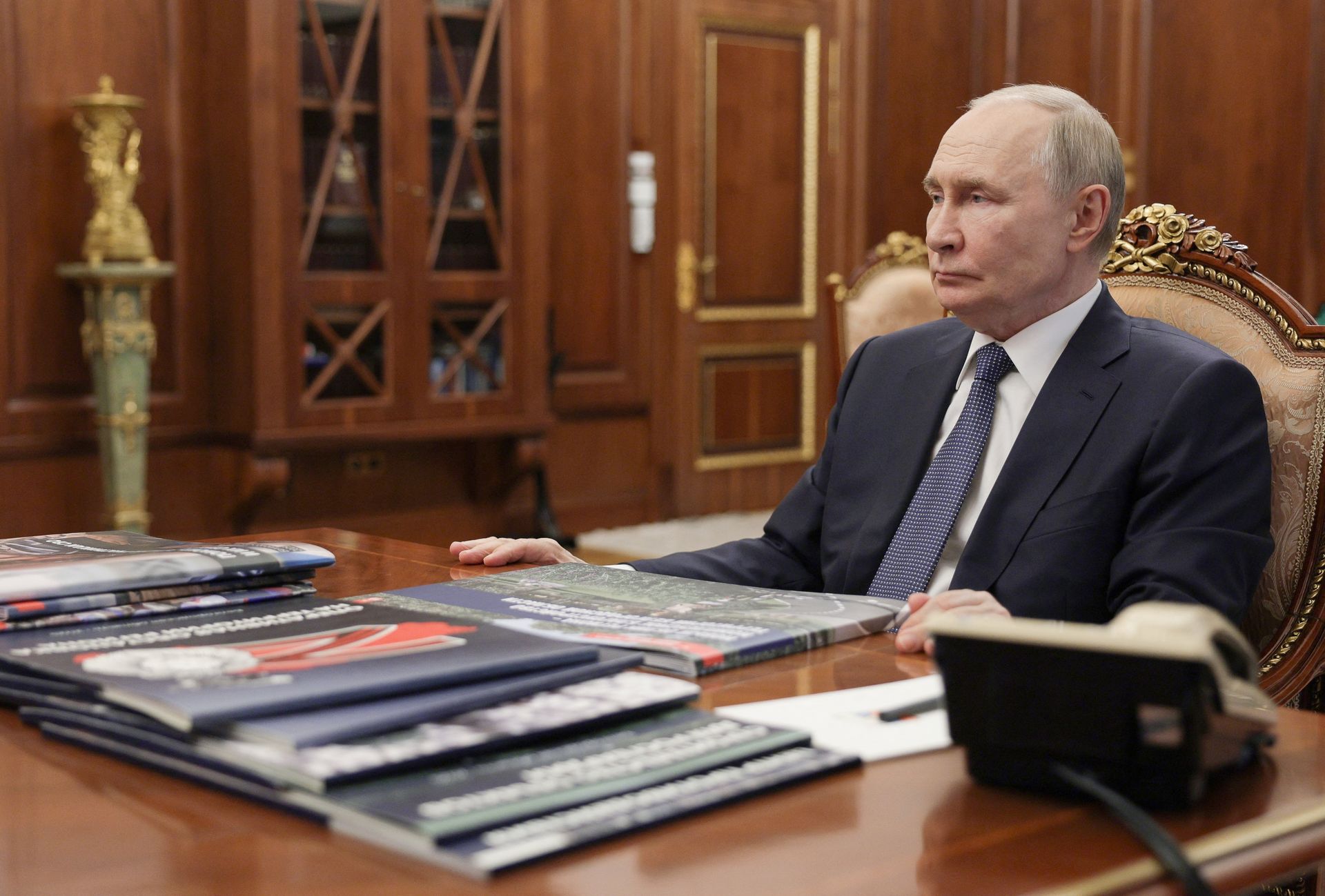 Russian President Vladimir Putin meets with Belgorod Region Governor in Moscow on July 11, 2025. (Mikhail Metzel/Pool/AFP via Getty Images)
Russian President Vladimir Putin meets with Belgorod Region Governor in Moscow on July 11, 2025. (Mikhail Metzel/Pool/AFP via Getty Images)
Without crushing sanctions on Russia or a surge in U.S. weaponry, Kyiv's only remaining hope could be European troops on the ground in Ukraine providing a deterrence force against further Russian aggression — something Barrons said is completely off the table.
"The discussion, which I think is completely naive, is any thought of European or indeed anybody else's forces being in Ukraine without there being a settlement that is based on the consent of both parties," he said.
"It is pointless to talk about putting troops in advance of knowing what those terms are, because nobody will do it. Nobody will do it," he said.
Ukraine’s occupied territories
No matter what happens in capitals across the globe, life under Russian occupation goes on – and so does the resistance.
Russia continues to entrench its control over the occupied territories, persecuting those who are overtly pro-Ukrainian, flooding all Ukrainians with Russian propaganda, and forcing them to obtain Russian passports just to access basic services like medical care.
But regardless of the uncertainty emanating from the outside world, a multitude of Ukrainian resistance movements continue their work — Atesh, Zla Mavka, the Yellow Ribbon movement, and the Crimean Combat Seagulls, to name just a few.
"The U.S. withdrawal of assistance to Ukraine has no impact on our activities. Our movement has never been dependent on external support — we follow solely the position of the Ukrainian government and act in the interests of liberating our lands," an Atesh representative told the Kyiv Independent.
"Our agents will continue to resist the occupation, regardless of the international situation. Resistance to the Russian occupiers existed before foreign aid and will continue even if this aid is completely stopped," they added.
🔥 On Ukraine’s Constitution Day, an Atesh agent sabotaged a rail relay near Yasynuvata. Fuel train delayed — enemy logistics disrupted. Donbas is Ukraine! Contact: @ruslan_atesh_ua #RussianUkrainianWar pic.twitter.com/Dbr0D2AEpS
— ATESH_eng (@atesh_eng) June 28, 2025
Russia currently occupies roughly 20% of Ukraine's territory. This includes the whole of Crimea occupied in 2014 and large parts of the Donetsk, Luhansk, Zaporizhzhia, and Kherson oblasts.
Moscow illegally declared the annexation of the latter four regions in 2022 and insists on Ukraine's full withdrawal from them as part of a peace deal, even though it does not control them completely.
Despite the bleak outlook, Ukraine's resistance movements have no choice but to fight on or submit to Russia.
"No matter what kind of support Ukraine receives, Zla Mavka will continue to resist. The realities may change, but the fight will persist. Recent news impacts many people morally, but it doesn’t stop them from doing everything they can," an activist from the female resistance movement Zla Mavka told the Kyiv Independent.
"We also understand that this could significantly prolong our liberation. Under the so-called 'ceasefire,' the Russians will feel much more 'at ease' here, so mentally we are already preparing for possible hardships," she added.
"The world may tremble, but we’ll keep doing our part…"
Ukrainian soldiers
Hundreds of miles from Kyiv, and thousands of miles from Washington, Ukraine's soldiers on the front lines are those who bear the brunt of decisions taken in the two capitals.
After nearly 3.5 years of fighting, compounded by manpower and equipment shortages, most are exhausted — but far from beaten.
"I don't want to live by Putin's imperial rules, living like you’re in a prison," Artem, a soldier from a mechanized brigade, told the Kyiv Independent. Following the security protocols of Ukrainian military, Artem isn't identified by his full name.
"The desire to win and return all the territories taken by Russia is much stronger than fatigue."
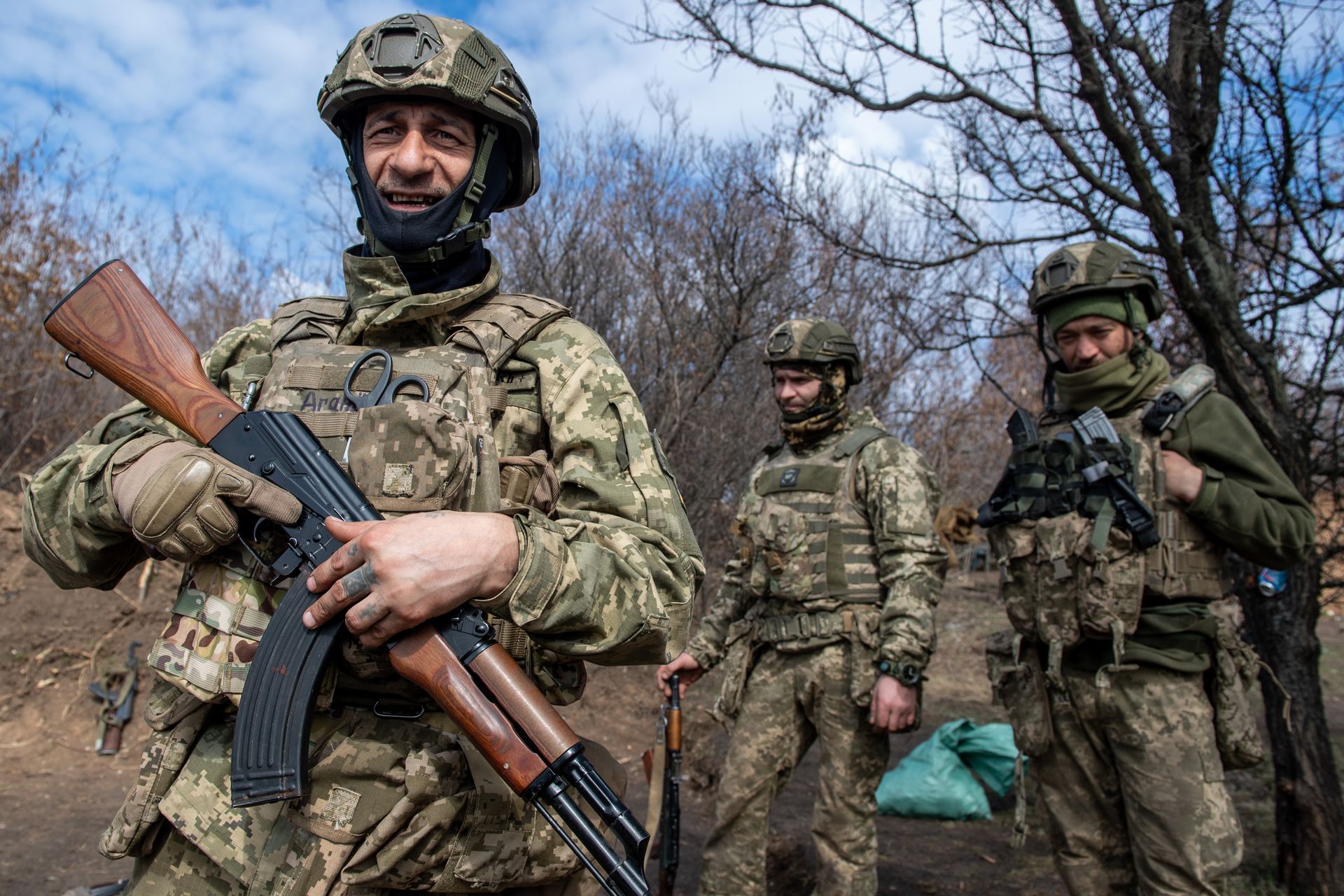 Aganiok from the Special Purpose Battalion 'Shkval,' part of Ukraine's 59th Assault Brigade, takes part in a training exercise near Donbas, Ukraine on March 20, 2025 (Thomas Krych/Anadolu via Getty Images)
Aganiok from the Special Purpose Battalion 'Shkval,' part of Ukraine's 59th Assault Brigade, takes part in a training exercise near Donbas, Ukraine on March 20, 2025 (Thomas Krych/Anadolu via Getty Images)
But there's no denying the front-line situation is currently bleak for Ukraine.
Russia is intensifying its offensive, enduring heavy losses, but still slowly grinding forward. The Ukrainians are just trying to survive and hold onto their positions.
And while lengthy and complex conversations about U.S. military aid play out at the highest diplomatic levels halfway around the world, the motivation of a Ukrainian soldier is often far simpler — to keep themselves and their comrades alive.
Another soldier, also named Artem, a machine gunner in the 80th Air Assault Brigade until he received a service-ending injury in 2024 and has fought since his hometown of Luhansk was occupied in 2014, said it was important for him to pass down the knowledge he learned while in service.
"When the war began, we had a fully equipped, trained contract army," he told the Kyiv Independent.
"Unfortunately, it is the case that a war goes on and people die and die."
The Ukrainian people
A poll conducted in March revealed more than 80% of Ukrainians believe the country must continue fighting no matter what, even if Washington ends all support for Kyiv, and Russian attacks continue to escalate.
War veteran and former prisoner of war (POW) Maksym Kolesnikov said the survey shows "Ukrainians are prepared to hold on despite the intensifying terror against the civilian population."
"Most Ukrainians understand that the consequences of capitulation would be far worse than the attacks," he says.
[Content truncated due to length...]
From The Kyiv Independent - News from Ukraine, Eastern Europe via this RSS feed
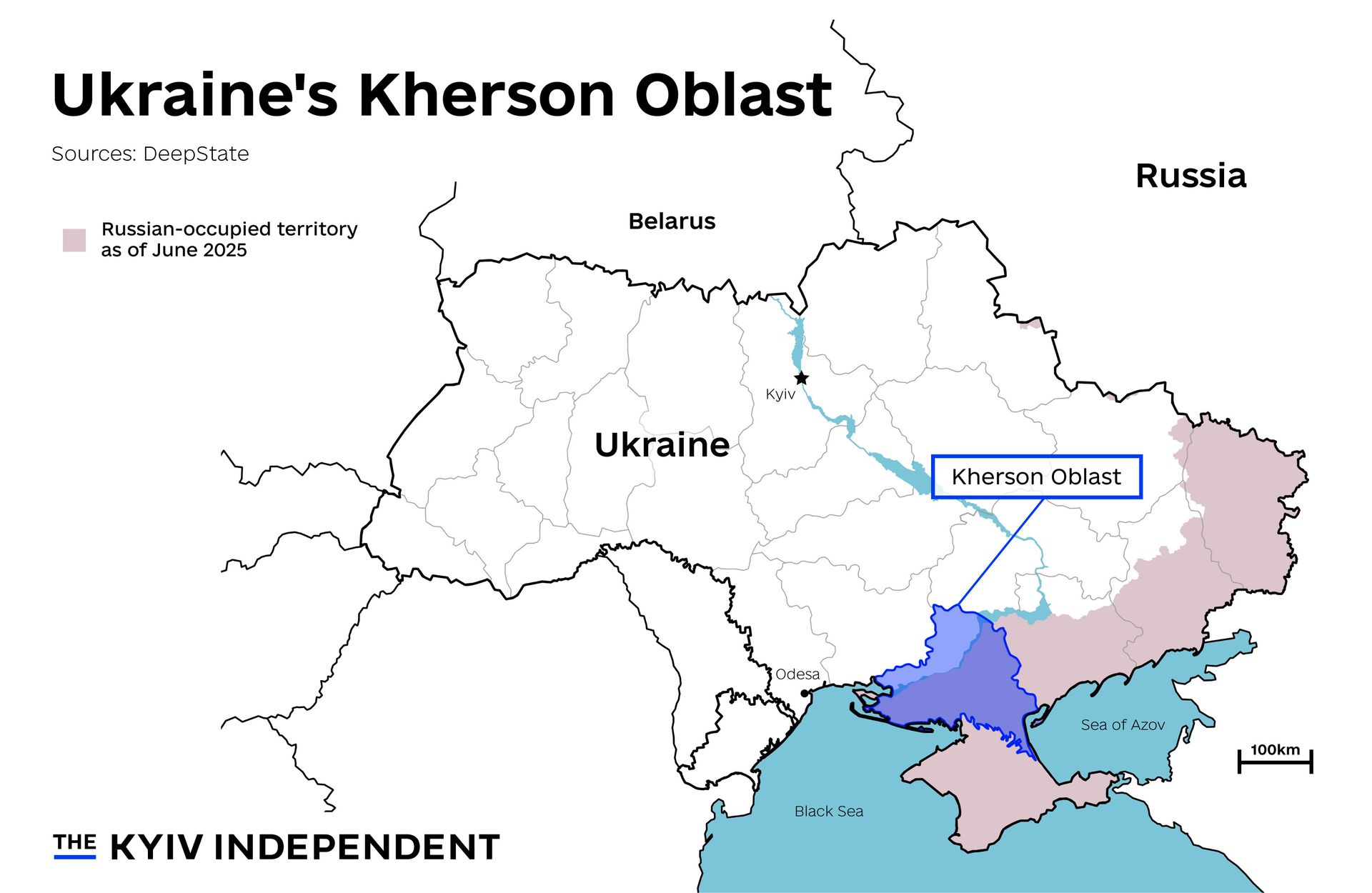
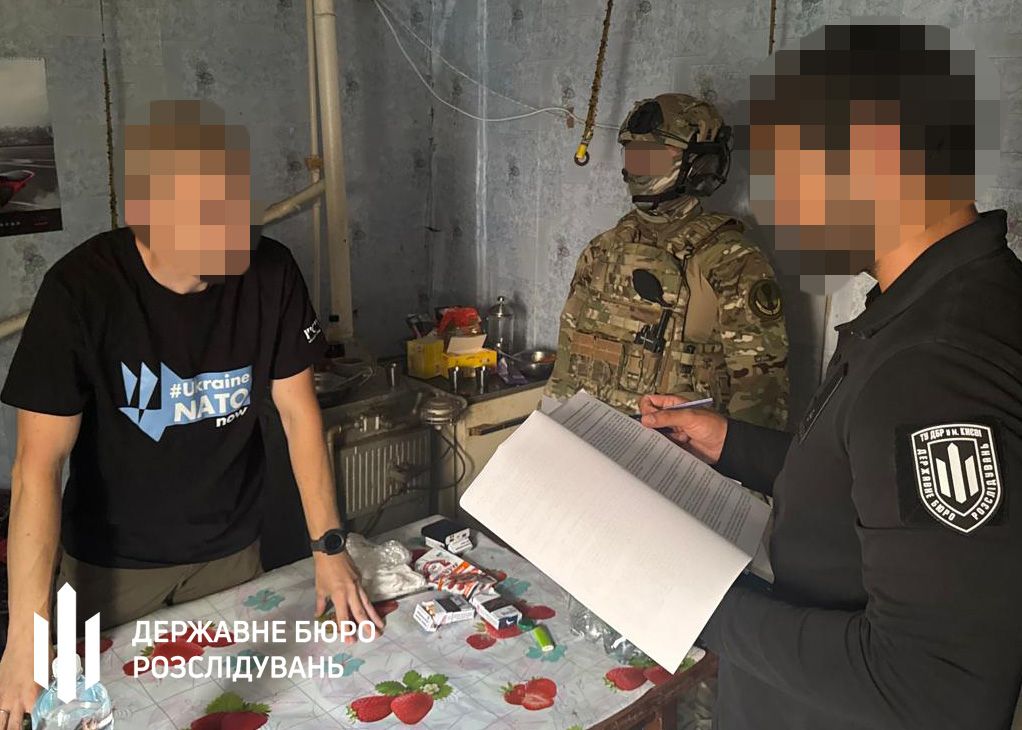 A photo released by the State Bureau of Investigations on July 11, 2025, of searches at Vitaliy Shabunin's military post in Kharkiv Oblast. (State Bureau of Investigations)
A photo released by the State Bureau of Investigations on July 11, 2025, of searches at Vitaliy Shabunin's military post in Kharkiv Oblast. (State Bureau of Investigations)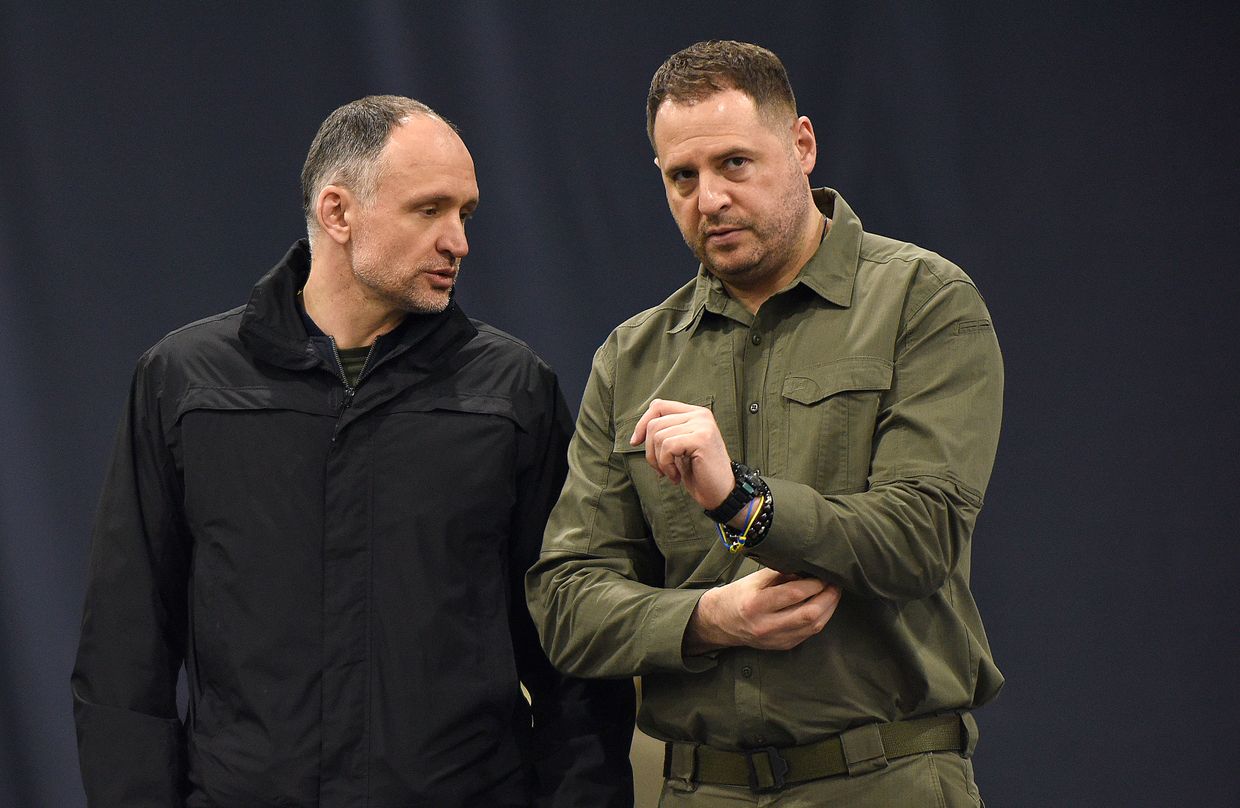 President Volodymyr Zelensky's chief of staff Andriy Yermak (R) and his controversial deputy Oleh Tatarov attend a graduation ceremony for police academies in Kyiv on April 12, 2023. (Kaniuka Ruslan / Ukrinform/Future Publishing via Getty Images)
President Volodymyr Zelensky's chief of staff Andriy Yermak (R) and his controversial deputy Oleh Tatarov attend a graduation ceremony for police academies in Kyiv on April 12, 2023. (Kaniuka Ruslan / Ukrinform/Future Publishing via Getty Images) U.S. President Donald Trump and President Volodymyr Zelensky meet during the NATO Heads of State and Government Summit in The Hague, Netherlands on June 25, 2025. (Anadolu via Getty Images)
U.S. President Donald Trump and President Volodymyr Zelensky meet during the NATO Heads of State and Government Summit in The Hague, Netherlands on June 25, 2025. (Anadolu via Getty Images) President Volodymyr Zelensky speaks to the media during a press briefing after his phone talks with the U.S. President Donald Trump on May 19, 2025. (Sergei Supinsky/AFP via Getty Images)
President Volodymyr Zelensky speaks to the media during a press briefing after his phone talks with the U.S. President Donald Trump on May 19, 2025. (Sergei Supinsky/AFP via Getty Images) Number of Russian drones launched against Ukraine in May 2024 — June 2025. (Nizar al-Rifai/The Kyiv Independent)
Number of Russian drones launched against Ukraine in May 2024 — June 2025. (Nizar al-Rifai/The Kyiv Independent) A map of Ukraine and its Russian-occupied territory. (Lisa Kukharska / The Kyiv Independent)
A map of Ukraine and its Russian-occupied territory. (Lisa Kukharska / The Kyiv Independent) Evacuation of civilians from the city by the forces of the National Police of Ukraine "White Angels" unit on June 19, 2025, in Pokrovsk, Donetsk Oblast, Ukraine. (Kostiantyn Liberov/Libkos/Getty Images)
Evacuation of civilians from the city by the forces of the National Police of Ukraine "White Angels" unit on June 19, 2025, in Pokrovsk, Donetsk Oblast, Ukraine. (Kostiantyn Liberov/Libkos/Getty Images) Russian territorial gains in Ukraine in 2024-2025. (Nizar al-Rifai/The Kyiv Independent)
Russian territorial gains in Ukraine in 2024-2025. (Nizar al-Rifai/The Kyiv Independent) Burnt cars lie in the street on June 19, 2025 in Pokrovsk, Donetsk Oblast, Ukraine. (Kostiantyn Liberov/Libkos/Getty Images)
Burnt cars lie in the street on June 19, 2025 in Pokrovsk, Donetsk Oblast, Ukraine. (Kostiantyn Liberov/Libkos/Getty Images) Russian monthly production of the various types of missiles according to data obtained by HUR and shown to the Kyiv Independent in June 2025. (Nizar al-Rifai/The Kyiv Independent)
Russian monthly production of the various types of missiles according to data obtained by HUR and shown to the Kyiv Independent in June 2025. (Nizar al-Rifai/The Kyiv Independent) A fire breaks out over the city during Russian air attack on July 10, 2025 in Kyiv, Ukraine. (Ivan Antypenko/Suspilne Ukraine/JSC UA:PB via Getty Images)
A fire breaks out over the city during Russian air attack on July 10, 2025 in Kyiv, Ukraine. (Ivan Antypenko/Suspilne Ukraine/JSC UA:PB via Getty Images) Targets in Ukraine's Operation Spiderweb in June 2025. (Nizar al-Rifai/The Kyiv Independent)
Targets in Ukraine's Operation Spiderweb in June 2025. (Nizar al-Rifai/The Kyiv Independent) President Volodymyr Zelensky (R) and Commander-in-Chief of the Armed Forces of Ukraine Oleksandr Syrsky in front of the first batch of Ukrainian-made drone missiles Peklo (Ukrainian for "hell"). (Genya Savilov/AFP via Getty Images)
President Volodymyr Zelensky (R) and Commander-in-Chief of the Armed Forces of Ukraine Oleksandr Syrsky in front of the first batch of Ukrainian-made drone missiles Peklo (Ukrainian for "hell"). (Genya Savilov/AFP via Getty Images) President Volodymyr Zelensky, France's President Emmanuel Macron and Britain's Prime Minister Keir Starmer attend a meeting during the European Political Community (EPC) summit, in Tirana on May 16, 2025. (Ludovic Marin/AFP via Getty Images)
President Volodymyr Zelensky, France's President Emmanuel Macron and Britain's Prime Minister Keir Starmer attend a meeting during the European Political Community (EPC) summit, in Tirana on May 16, 2025. (Ludovic Marin/AFP via Getty Images) Russian President Vladimir Putin meets with Belgorod Region Governor in Moscow on July 11, 2025. (Mikhail Metzel/Pool/AFP via Getty Images)
Russian President Vladimir Putin meets with Belgorod Region Governor in Moscow on July 11, 2025. (Mikhail Metzel/Pool/AFP via Getty Images) Aganiok from the Special Purpose Battalion 'Shkval,' part of Ukraine's 59th Assault Brigade, takes part in a training exercise near Donbas, Ukraine on March 20, 2025 (Thomas Krych/Anadolu via Getty Images)
Aganiok from the Special Purpose Battalion 'Shkval,' part of Ukraine's 59th Assault Brigade, takes part in a training exercise near Donbas, Ukraine on March 20, 2025 (Thomas Krych/Anadolu via Getty Images)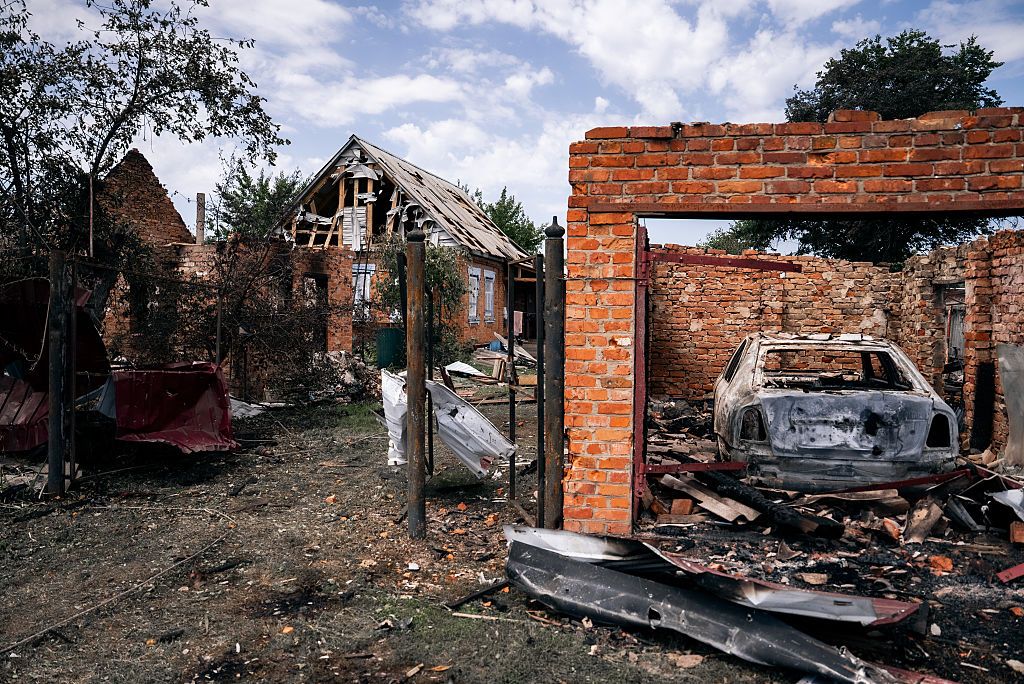 Wreckage of car lies amid debris in the yard of damaged house after Russian drone attack on July 9, 2025 in Nedryhailiv, Ukraine. )Oleksandr Oleksiienko/Kordon.Media/Global Images Ukraine via Getty Images)
Wreckage of car lies amid debris in the yard of damaged house after Russian drone attack on July 9, 2025 in Nedryhailiv, Ukraine. )Oleksandr Oleksiienko/Kordon.Media/Global Images Ukraine via Getty Images)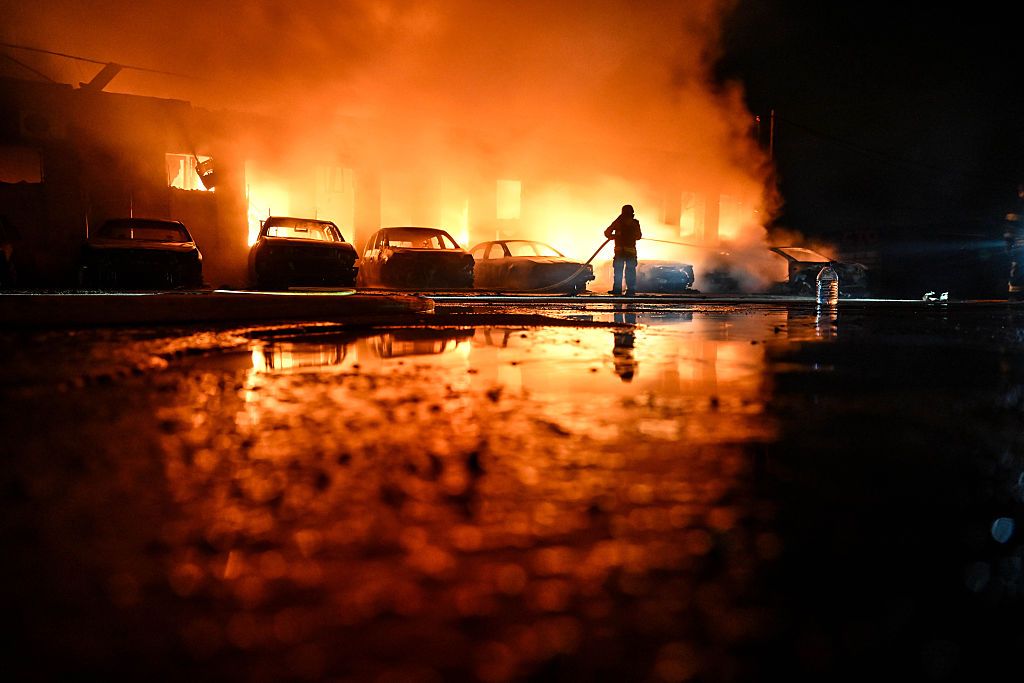 A rescuer pours water onto burning cars during a response effort to a Russian drone attack on Zaporizhzhia, Ukraine, on June 18, 2025. (Ukrinform/NurPhoto via Getty Images)
A rescuer pours water onto burning cars during a response effort to a Russian drone attack on Zaporizhzhia, Ukraine, on June 18, 2025. (Ukrinform/NurPhoto via Getty Images)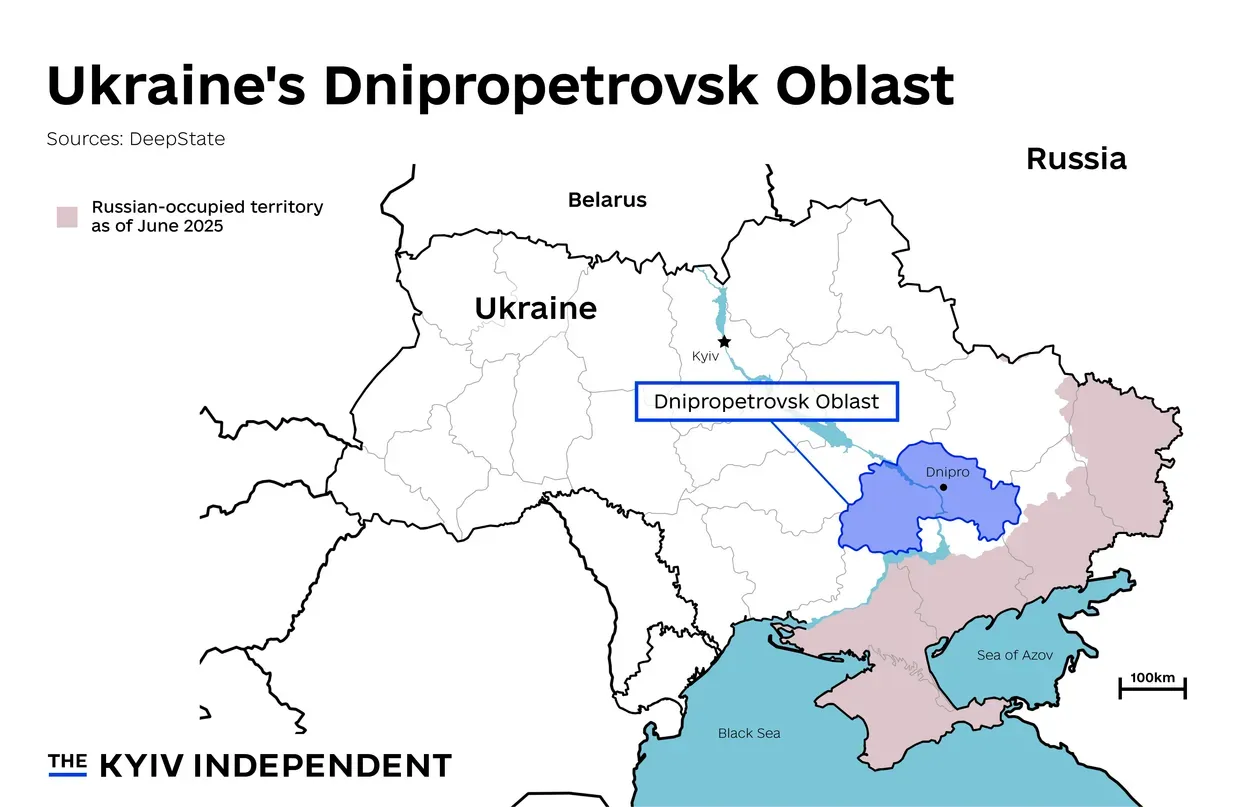 Ukraine's Dnipropetrovsk Oblast (Nizar al-Rifai/The Kyiv Independent)
Ukraine's Dnipropetrovsk Oblast (Nizar al-Rifai/The Kyiv Independent)